How to write a process essay
- August 25, 2023
Process essays are one of the most common types of essays . It’s simply explaining a process of how to do something.
In this article, we’ll show you how to write a process essay in steps with interactive examples.
Process essay definition
Let’s take a look at the steps outlined below to write a clear and effective process essay.

Choose a topic
You should start by choosing a topic that not only interests you but also attracts your target audience.
Whether it’s brewing the perfect cup of coffee or conquering the art of origami, your topic should be engaging and well-defined. Let’s have a look at topic examples:
- Crafting Exquisite Miniature Bookbindings
- Building a Sustainable Vertical Garden
- Making the Perfect Cup of Coffee
So for this guide, I’ve chosen “Making the Perfect Cup of Coffee”. Now let’s continue with the next steps.
Create a process essay outline
Now that you’ve your topic at hand, it’s time to create an outline to present the steps chronologically. Outline will also help you organize your thoughts and ideas so you won’t get lost during the writing process.
Let’s examine this step with an example of a process essay explaining “Making the Perfect Cup of Coffee”.
Process essay outline example
- Thesis statement
- Provide safety precautions if necessary.
- Address to the reader
- Provide any variations or customization options if applicable.
- End with a memorable concluding thought or call to action.
By presenting the steps in chronological order, your readers can follow the process smoothly.
During this step, just make sure to:
- Expand on each step you outlined earlier.
- Use clear and concise language.
- Make use of bullet points or numbered lists to make the process visually appealing.
After completing the outline, it’s time to write an interesting introduction.
Write an introduction
- Hook the reader's interest with a hook sentence
- Offer a brief overview of the topic and its significance
- Introduce and explain the process with a thesis statement at the end of introduction
Process essay introduction example
Introduction
Now that we have an intro on our hand, you need to tell what materials you need to finish the process.
Write the materials needed for the process
Listing the necessary materials for the process is a best practice for process essays. Typically found just after the introduction, this paragraph is devoted to outlining the necessary materials.
Here, p rioritizing the list is important; the more influential a component is, the higher its position on the list should be.
Example material list for process essay
Body paragraphs
Materials needed
- High-quality coffee beans that align with your flavor preference.
- A grinder for optimal flavor extraction.
- Equipment for brewing methods, such as a pour-over apparatus, a drip coffee maker, a French press, or an espresso machine.
- Fresh and clean water for brewing.
- Optional additives like milk, cream, sugar, flavored syrups, or other preferred elements.
Start writing the process
Right after listing the materials needed, it’s time to start writing the process itself.
When describing your process, be careful not to make it too complicated. To keep your readers on track, use transitional words like “after,” “eventually,” “first,” “then,” and others help you maintain an understandable tone.
Or simply use a 1,2,3, bullet point structure as seen in example below to remind readers of their step during the process.
Body paragraphs - Process writing example
Materials needed ...
- Grind the beans just before brewing for optimal freshness. Use a burr grinder and adjust the coarseness to match your brewing method (coarse for French press, fine for espresso).
- Weigh your coffee grounds using a scale. A standard ratio is 1 to 2 tablespoons of coffee per 6 ounces of water, but adjust to your taste.
- Ensure the water is heated to the ideal temperature, typically between 195-205°F (90-96°C). Water that's too hot or too cold can affect the taste.
- Pay attention to the brewing time. Generally, 4-5 minutes is suitable for most methods, but again, adjust based on your preference.
- After finishing, regularly clean your coffee maker or French press to prevent rancid oils and residue from affecting your coffee's taste.
As seen from the example above, using an imperative language structure is generally preferable. It makes total sense as you’re describing a process in steps and usually don’t need a full sentence structure.
Give tips and supporting details
After explaining the process above, it’s now time to provide tips and supporting details. Here, make use examples, tips, and even warnings if necessary.
In other words, anticipate the questions your readers might have and address them as you go along.
Body paragraphs - Supporting details
Supporting details & tips
- Ensure safe handling of hot water and coffee-making equipment.
- Water that's too hot can result in over-extraction, while water that's too cold won't extract enough flavor.
Write a conclusion
At this step, you simply need to write a conclusion paragraph to end your process essay. First summarize the key points, and restate the process in a concise and short sentence. And finally, finish your process essay by a memorable sentence or a call-to-action.
Process essay conclusion example
Revise and polish your essay.
Now that you’ve written your essay, take a breath, and then come back for some editing. Check for consistency, correct sentence structure, efficient transitions , tense selection , and other linguistic issues that may arise.
If possible, make use of proofreading tools like QuillBot or Grammarly .
- Think about potential reader misunderstandings and address them. If needed, explain what should be avoided.
- Offer explanations for steps that might seem unusual or complicated.
- Define any unfamiliar terms or materials that the reader might not understand. This ensures clarity in your essay.
So you’ve successfully learned how to write a captivating process essay. Remember, practice makes perfect. The more you write, the better you’ll become.
Recently on Tamara Blog
How to write a discussion essay (with steps & examples), writing a great poetry essay (steps & examples), how to write a process essay (steps & examples), writing a common app essay (steps & examples), how to write a synthesis essay (steps & examples), how to write a horror story.
- PRO Courses Guides New Tech Help Pro Expert Videos About wikiHow Pro Upgrade Sign In
- EDIT Edit this Article
- EXPLORE Tech Help Pro About Us Random Article Quizzes Request a New Article Community Dashboard This Or That Game Popular Categories Arts and Entertainment Artwork Books Movies Computers and Electronics Computers Phone Skills Technology Hacks Health Men's Health Mental Health Women's Health Relationships Dating Love Relationship Issues Hobbies and Crafts Crafts Drawing Games Education & Communication Communication Skills Personal Development Studying Personal Care and Style Fashion Hair Care Personal Hygiene Youth Personal Care School Stuff Dating All Categories Arts and Entertainment Finance and Business Home and Garden Relationship Quizzes Cars & Other Vehicles Food and Entertaining Personal Care and Style Sports and Fitness Computers and Electronics Health Pets and Animals Travel Education & Communication Hobbies and Crafts Philosophy and Religion Work World Family Life Holidays and Traditions Relationships Youth
- Browse Articles
- Learn Something New
- Quizzes Hot
- This Or That Game
- Train Your Brain
- Explore More
- Support wikiHow
- About wikiHow
- Log in / Sign up
- Education and Communications
- College University and Postgraduate
- Academic Writing
How to Write a Process Essay
Last Updated: December 6, 2023 Fact Checked
This article was co-authored by Jake Adams . Jake Adams is an academic tutor and the owner of Simplifi EDU, a Santa Monica, California based online tutoring business offering learning resources and online tutors for academic subjects K-College, SAT & ACT prep, and college admissions applications. With over 14 years of professional tutoring experience, Jake is dedicated to providing his clients the very best online tutoring experience and access to a network of excellent undergraduate and graduate-level tutors from top colleges all over the nation. Jake holds a BS in International Business and Marketing from Pepperdine University. This article has been fact-checked, ensuring the accuracy of any cited facts and confirming the authority of its sources. This article has been viewed 167,030 times.
A process essay, otherwise known as a how-to essay, tells a reader how to perform a particular task. The best process essays follow a clear step-by-step organization. Start by providing your reader with a time estimate and general summary of the task. Then, move on to a more detailed explanation of each and every necessary step. When you are finished with your essay, read it over carefully to ensure that you haven’t left anything out.
Getting Ready to Write

- For example, a process essay intended for professional chefs could probably skip a description of how to chop carrots and just say, “Finely chop the carrots,” instead.

- You could also include a comprehensive “Things You’ll Need” section at the beginning of the paper. Or list the materials needed after the introduction.
- If an item on the list is a bit unusual, such as a particular type of hand tool, then make sure to clearly introduce it within the text. For example, “The pin hammer has a finer tip than a standard hammer, making it suitable for more detailed work.” You can also include a picture of the item, particularly if the essay will be published online.

- If you are writing an essay about how to cook lasagna, your initial outline might just state, “Mix in basil.” Before you start writing, you could expand your outline to say, “Briefly mention taste differences between dried and fresh basil.”
- Note that the more specific your article or essay topic, the more specific your details needs to be.
Crafting an Introduction

- For instance, you might write, “The process of preparing lasagna has a rich heritage all of its own.”

- If your process essay focuses on a cooking task, this is where you might advise your readers to consult the ingredients or materials list and put every item on the counter.
- For example, you might write, “This recipe requires 30 minutes of active preparation time, along with 45 minutes of baking time.”

- For example, your thesis might be, “This essay will explore how to create a complicated lasagna dish in a short period of time by preparing the noodles and sauce in advance.”
Writing Your Body Paragraphs

- Be especially careful with items that contain multiple steps. Make the transitions clear and acknowledge prior steps regarding a particular item, if applicable.

- For instance, when making pasta, consider writing a paragraph on how to boil pasta and another paragraph on how to make the sauce. This separates the ideas for easy clarification.

- For instance, you could write, “Next, place the pot on the stove,” to move from one paragraph to the next.

- For example, you could write, “This essay shows…” instead of “I’ll show.”

- For example, you might caution a reader to, “Cook the meat until it is no longer red in the center.” This advice will help them to avoid a foodborne illness.
Wrapping It Up

- In the case of the recipe, you could write something like, “You now have a bowl of boiled pasta and finished Bolognese sauce. Serve up plates of pasta and sauce to your family, topping them with parmesan, if desired. You can serve garlic bread or a side salad with this dish, too.”

- A simple example for our newly-made dinner might be, "And there you have it! A delicious yet quick meal fit for the entire family that you can make over and over again without complaint. Next time, experiment with different herbs and spices to find your own spin on this classic dish."

- Look to see if there are places where you can eliminate steps or condense your instructions. A reader is more likely to finish directions that they can easily skim through.
- Ask someone to read through the essay to see if they can understand the process. If possible, pick someone from your intended audience demographic.

- Don’t rely on spell-check alone, as it cannot account for context and doesn’t catch every error.
Expert Q&A

- If there are alternative ways to do a particular step in the process, make sure to mention these as you go along. Thanks Helpful 0 Not Helpful 0

- Give your readers pacing instructions as well. If they need to go slowly while performing a certain task, tell them early on. The same rule applies if a task requires speed for success. Thanks Helpful 0 Not Helpful 0
You Might Also Like

- ↑ Jake Adams. Academic Tutor & Test Prep Specialist. Expert Interview. 20 May 2020.
- ↑ https://www.grammarly.com/blog/essay-outline/
- ↑ https://www.georgebrown.ca/sites/default/files/uploadedfiles/tlc/_documents/hooks_and_attention_grabbers.pdf
- ↑ https://courses.lumenlearning.com/atd-clinton-englishcomp/chapter/2-the-process-essay/
- ↑ http://www.butte.edu/departments/cas/tipsheets/style_purpose_strategy/procress_paper.html
- ↑ https://www.grammarly.com/blog/readability-scores/
About This Article

To write a process essay, begin by writing an introduction that grabs the reader’s attention so they’ll want to keep reading. Then, end the first paragraph with a thesis statement presenting a problem for which you are offering a solution. Next, explain the process, making each step its own paragraph, and using transitions like "next" or "then" to move from one task to another. As the final step, let the reader know what to expect from the finished product and what to do with it. Finally, close your essay by reiterating why the process is helpful to the reader. For tips from our Education reviewer on how to proofread for common errors in a process essay, read on! Did this summary help you? Yes No
- Send fan mail to authors
Reader Success Stories
ChinaTeacherAlan
Dec 2, 2018
Did this article help you?

Juliana Kim
Jan 8, 2017
Nov 19, 2016
Hasan Hasan
Dec 16, 2016
Dec 11, 2018

Featured Articles

Trending Articles

Watch Articles

- Terms of Use
- Privacy Policy
- Do Not Sell or Share My Info
- Not Selling Info
wikiHow Tech Help Pro:
Develop the tech skills you need for work and life
How to Write a Process Essay

The process essay, also known as the "how-to" essay, is commonly written for people or companies that need tutorials or a set of instructional steps. Whether it's building a robot or cooking a chocolate cake, process essays use a similar format for any variations. They follow a step-by-step style, with the initial step influencing the second, which influences the third, and so on. Each step carries its own importance, and a poor explanation of one step can ruin the entire process. It's important to stay concise and efficient. However, before you begin writing your essay, you should do some small preparations. Let's discover them with our research writing service .
What Is a Process Paper?
A process essay is a type of essay that explains a process step by step and gives guidance for a certain process, working mechanism, procedure, etc. Process essays range from very simple ones, such as instructions for how to ride a bicycle, to more complex ones, such as a chemistry lab report of an oxidative reaction experiment. The goal of a process paper is to give its readers guidance and directions.
Feeling Overwhelmed Writing a Process Essay on Your Own?
Simply send us your paper requirements, choose your paper writer and we’ll get it done fast.
A process paper is characterized, first of all, by explaining a process using a description. Some words that are frequently used in process essays are “further”, “then”, “next”, “first”, “last”, “finally”, and “initially”. It is really important to remember that every process essay includes features, such as:
- clear and straightforward narration - the last thing you want to do is to confuse your reader with complex language and an unorganized thought thread;
- chronological order - avoid skipping steps and shifting them around, as it will result in misunderstanding and frustration for the readers;
- transition words - make sure to separate the next step from the previous ones by using transition words;
- descriptions of the steps - make sure your steps are clear and easy to follow.
There are several types of process essays. The first one is directional - it explains the “how to” for something. It can take on a wide range of subjects, such as how to apply for a credit card, how to get your driver’s license, how to plan a wedding, etc. The outcome of the directional essay should be a result. In the cases of the examples above: a credit card, a driver’s license, or a carefully planned wedding. The other type of process paper is informational - it explains how something works. Here are some examples: how a weather forecast is determined, how a space rocket works, how intermittent fasting changes your body, etc. An informational essay explains something to a reader and does not necessarily end up with a result, like directional does.
Another type of essay that is similar to a process essay is a process analysis essay. The biggest difference is that a process analysis essay not only explains the steps, but also analyses them in depth. It has all of the characteristics of a process essay, although goes into more detail about the causes and consequences of every step.
If you need any additional information for process analysis essays, check out our article: HOW TO WRITE A PROCESS ANALYSIS ESSAY
Writing a process essay is not extremely difficult. By following simple rules and a set of steps, a successful, well-structured essay can be guaranteed.
Prepare The Small Stuff
Here we gathered some small general tips and advice that you should follow throughout your writing process to make sure that all of the expectations of a process paper are met.
- Determine the Audience's Skill Level. It's important to base the level of complexity of the essay on who the readers will be. For example, if you need to teach a friend how to do a simple fix or create a certain tool, then it would be most reasonable to stick to more basic terminology. However, if you are writing an essay for your astrophysics professor about the creation of a black hole in the universe, use more sophisticated and informative terminology.
- Make a List of Materials. Obviously, the creation of anything comes with some prerequisites. Whether it's items or ideas, the importance of knowing the necessities beforehand and having them ready to go is essential. Make sure to place each item in accordance with its importance. The more impactful a part is, the higher up on the list it should be.
- Write out Each Task. In a step-by-step tutorial, each individual task carries some sort of weight. Since an entire process can not be complete if a step is skipped, it's crucial to write out every single step. However, don't go overboard in your explanations. It's not necessary to bring the tutorial to a microscopic level, but each step should be understandable and competent.
If you still have difficulty writing, you can get essay help online from our service.
Process Essay Topics
Choosing a topic for a process paper can be quite challenging. A good place to start is with your passions. If you pick something you are excited about, you can make it interesting for your readers and fun for yourself to write about. If your professor limits you to write a process essay on something you have very little knowledge of, choose a topic that is intriguing and triggers your interest. Then, conduct enough thorough research to make sure you understand everything perfectly before you go ahead and try to explain it to someone else.

Another very important thing to consider while writing a process essay is your audience. It is highly unlikely that college students are interested in instructions for “How to Get Into Your Dream School” or “How to Pass Your SATs”. Make sure your topic relates to the subject you are studying and you are following your professor’s prompt guidelines.
Here are some ideas that might be of interest for you:
- How to lose weight on a keto diet
- How your immune system fights COVID-19
- How to start selling on Amazon
- How to improve your credit score
- How to decrease your social media usage
- How to apply for unemployment insurance
- How to improve your college performance
- How to open your first bank account
It's important to note that these essay topics are just some common examples used by several college students for their course papers. Feel free to use any one of them if you want, or think of one on your own. Just make sure it's a PROCESS!
Process Essay Outline
Most essay outlines follow the standard scheme: Intro > Body Paragraphs > Conclusion . follow the standard scheme: Intro > Body Paragraphs > Conclusion. A good process essay outline should look like this:
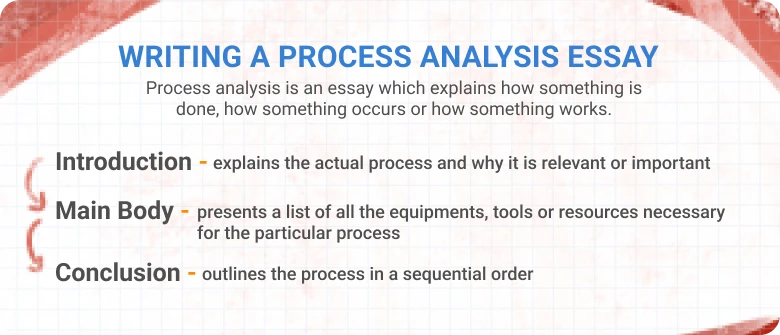
- Introduction — brief your reader on your topic, explain why you have chosen it and how you are planning to approach the explanation of the process.
- Body — the biggest part of your essay that should be divided into paragraphs for easier understanding and structure. Make sure each paragraph is flowing smoothly into the next one with connective words.
Paragraph 1. First step of the process. Explain what the step is, what the best way to perform it is, and how to avoid common mistakes when doing it.
Paragraph 2. The next step of the process (the same as in Paragraph 1). Thoroughly explain what this step is about.
- Conclusion . Here you need to explain why your instructions are valuable. It is your opportunity to persuade your reader(s) that the steps you presented and the process they learned will be useful for them in the future.
Every process is different: some can take a couple of minutes, while others can take months or years to complete. The length of the essay is generally based on the difficulty and number of steps it takes. However, the structure doesn't maneuver.
Introduction
The first thing that you want to do as a writer for your process paper is to help your readers be interested in your individual process. Be descriptive about it, paint a picture for your readers. A joke or a personal reference can be a great attention grabber and can pull your reader right in. For somebody to be keen on approaching your process, they have to express interest in it. Though, it generally goes without saying that many writers ignore this fact. Let's break it down into subsections:
- Give a little bit of historical background. People often want to know the origins of whatever it is that they're working on. Introducing this part of the process helps to intrigue your readers, as well as give them a sense of purpose for the task.
- Create an approximate timeframe. Unfortunately, your readers don't have all day to spend on this one event. In addition to learning about its purpose, people want to know how long the task will take. This way, they can decide how to break up the work. If it's a quick fix, then they can knock it out in one session. However, if it's a large-scale operation, then your readers will obviously have to create their own time schedule.
For example, let’s say that the topic of your essay is “How to Save Money”. You can start the introduction of your process essay by explaining that as a college student, you often find yourself in need of extra money and you are stuck with bad money habits. This will create a good connection with your readers, because almost everyone has been in a situation of needing to be savvy with their finances. Another thing you can mention is the importance of saving money and the multiple opportunities it presents, such as being able to invest it, being able to pay off a credit card debt, or being able to save up to avoid taking out a student loan.
Feeling Overloaded and Stressed?
Our professional writers are ready to help you 24/7!
Body Paragraphs
This is the point in the process essay where you start introducing the step-by-step process your readers will need to take. A lot of the time, it helps to break down each process into subsections. For example, if a step has many parts to it, it would be clever to create a paragraph on its own just for that step. Remember, it's important to keep things smooth and efficient. Break down the body paragraphs in unity with the steps. Let's go into more detail about each step:
Each step should be carefully explained. Every step will vary in length. Think about it: every instruction manual has several steps. Some are more difficult to comprehend or perform than others. For this reason, create your steps and explanations accordingly. You should be able to get a sense of their length and difficulty based on the explanation.
Don't forget to explain the purpose. People don't want orders barked at them aimlessly. Besides just accomplishing a task, people want to learn as they perform.
- Why did they do this?
- What was the purpose of this method?
- Why did we do it this way and not this other way?
To make everything flow smoothly use transitions. Make the steps flow one after another to create a well-structured essay. As you introduce the next step, consider using transition words like “next”, “now”, “then”, “so that”, etc.
Before writing the steps out in full sentences, it is a great idea to create an outline for your body paragraphs. Here is an outline for the body paragraphs of a process essay on “How to Save Money”:
Paragraph 1:
- keep track of your expenses
- organize your collected data
- decide what you can skimp on in your spendings
Paragraph 2:
- create a realistic budget
- check weekly to ensure you are sticking to it
- save 15% of every monthly income
- set a tangible goal for saving, such as a car
These process essay examples use only two body paragraphs, but feel free to include more to ensure a better understanding and cohesive flow for your paper. Although, do not include excessive unnecessary details that clutter your essay and make understanding it even more difficult. While writing your essay, include small brief explanations for each statement. For example, “Even though eating out and grabbing a coffee on your way to class sounds tempting, setting a budget and saving 15% of each of your monthly earnings aside can help you have enough to put down a downpayment on a new car.” Here the reader will understand that there is a direct relationship between each step and the result it is going to give.
Showing the readers that they are learning and not just repeating is one of the most effective ways to lock down their attention and keep them coming back!
After going through every step meticulously and explaining the whole process, a process essay needs a confident conclusion. This paragraph should be short, sweet, and to the point. It's main goal is to accomplish the following tasks:
- Discuss the main result. After the readers have completed the process, they should be left with a final result. It's important that you explain to your readers what the end result will look like, and what can be done with it.
- Restate the process’s general purpose. After completing the task, you obviously would like to know its overall purpose. When your readers feel that they have accomplished a challenge, learned something from it, and have a path to take the result towards, they will be satisfied!
- State your Overall Conclusion. To put a pretty tie around your process essay means that you need to neatly wrap things up! Restate some of the highlightable points as well as the process’s key overall purpose. Make sure that your readers feel accomplished after going through your process, and ensure that you strengthen the necessity of its purpose with a nice concluding sentence!
The conclusion of an essay on “How to Save Money” would explain that the completion of all of the steps will result in saving money that can be used for a specific goal or for rainy day fund purposes. You can mention the importance of every step and briefly repeat some of the key points.
Post-Writing Tips
Here are some final tips to wrap up your writing process. Use them as a checklist for a successful and coherent essay.
- Make sure the work is simple enough to follow. Worst-case-scenario: its author creates a feeling of absolute confusion in the reader’s mind. To avoid this problem, always remember that your readers can be beginners. Do not try to impress them with complicated words or sentences, use simple language to provide clear directions on how to do something. Give as many details as possible, but do it plainly. "Why is he making me do this?" "What was the purpose of this?" "I don't understand this step at all!" If the reader is asking themself these questions, then it's time to do some editing!
- Experiment and try it for yourself or ask a friend. There's no better way to experience success than to actively attempt your process through your own instructions. If everything truly makes sense, then you should have no problem solving the task using your own words. Even better, ask a peer to try it through your words to get an outside point of view.
- Choose the right topic for you and research it well
- Maintain a logical order of steps, make it easy to follow
- Avoid using imperative sentences - you do not want to sound like an Apple TV manual
- Explain terms that are most likely outside of most people’s range of common knowledge
If you have a ready-made essay but need to make significant changes to it, you can use our rewrite my essay service .
Process Essay Examples
Now that you know all about process essays and how to write them, we have prepared some great essay topic ideas in case you are stuck and cannot choose one:
Building a business from scratch is an intricate process that entails a number of steps. Each of these steps should have specific objectives and measurable outcomes.The following analysis gives the basic steps followed when building any business from scratch.
Saving can be defined as a differed consumption or keeping aside a portion of your income for unexpected future uncertainties or plans. Read for reason and actual steps for saving more money
Read also a thesis statement example from our author. In this article, you can learn something useful for yourself.
Still Need Help?
If you still feel like you could use some help with your process essay, do not hesitate to seek help from our writing service. Our writers specialize in a wide range of essays of different types including creative writing essay , process essays, and would be more than happy to assist you with writing, editing, or direction if you are feeling uneasy. Click the button below and college admission essay writer will process your requests fast.
Related Articles
.webp)
How To Write A Process Essay: Essay Outline, Tips, Topics and Essay Help
Throughout the course of education, you’ll need to write all sorts of papers. Some of them are well-known e.g. argumentative essays, or expository essays, while others are relatively unknown. Process essay belongs to the latter group. While the essay itself is something you’ve come across on multiple occasions, students don’t get to work on this assignment frequently. That’s why getting this assignment can be a huge source of stress. This guide helps avoid those stressful times with easy tips and tricks that you need for a good grade.
A process essay is a typical “how-to” paper that describes some process or workflow, hence the name. The primary idea behind this type of essay is to give a step-by-step explanation of a process that leads to a planned or expected outcome. The paper may revolve around a concrete or precise and an abstract process.
We can divide process essay into two major types:
- Directional – provides step-by-step instructions on how to get something done
- Informational – analyzes or explains a process
Benefits of Writing a Process Essay
Even though it’s not something we usually think about, every essay has its role that goes beyond the arguments or processes you discuss. We are talking about a greater purpose, the impact this essay will have on your skills. Believe it or not, every assignment in school or college has a goal to improve or develop some valuable skills and process essay is not an exception. Here are some skills you can develop with process essay:
- Analytical skills – every course of action is logical, has its own flow, and your goal is to represent that. In order to write this essay, you need to think analytically. That’s the best way to describe the dynamic of some process and keep the reader’s interest. Of course, you can transfer this skill to many other aspects of your life and future employment
- Prioritizing – essays require precise expressions, and vague language impairs the quality. While researching you’ll come across different info and resources, but not all of them can nor should be included in your paper. In order to make things work, you need to prioritize one piece of information over the other. That way, you’ll include valuable info only, without tainting your essay with unnecessary things
- Following instructions – every process has its beginning, middle, and end. Each step is equally important. The ability to describe every part of the process in a suitable manner improves your capacity of following instructions; which can come in handy in every aspect of your life
- Attention to detail – seemingly unimportant details play a huge role in every process or course of action. While writing the process essay, you need to pay attention to these details, in order to provide clear instructions or step-by-step guides, explanations, etc. At the same time, you’re sharpening this skill which can be practical at work (or any other part of your life) later on
The process of writing a process essay is often daunting for many students. But the good news is – you can order an essay online from professionals who can write it for you in a matter of hours. With the help of this essay, you will be able to explain the process of doing something in a clear and understandable way.

Finished papers
Customer reviews

Areas of Interest
Everything that happens in this universe (or beyond) is a process. The world is comprised of processes and each of them can be described in an essay. Therefore, your process essay can be about:
- Interpersonal communication
- Social media
Process Essay Outline
Wondering how to write a process essay if you’ve never worked on this assignment before? Or maybe you want to learn how to improve the structure of your paper for a better grade. This outline can help you:
- Hook – the first sentence that grabs the reader’s attention
- Identification – brief intro to the subject that will be discussed
- Thesis statement – announcement of the process (or its aspect) you will explain
- Support (topic) – every paragraph should focus on a specific part of the process and start with a clear indication of a factor you’ll discuss
- Explain – self-explanatory, you need to explain how it works, what to do with it, and other important info
- Evidence – like other types of essay, this type of paper requires using evidence to back up the info you used
- Discuss – more information about some particular part of the process, its importance, how it fits into the overall subject, etc.
- Conclusion – your conclusion should contain a brief summary of the thesis and the main parts of the process
Writing Tips
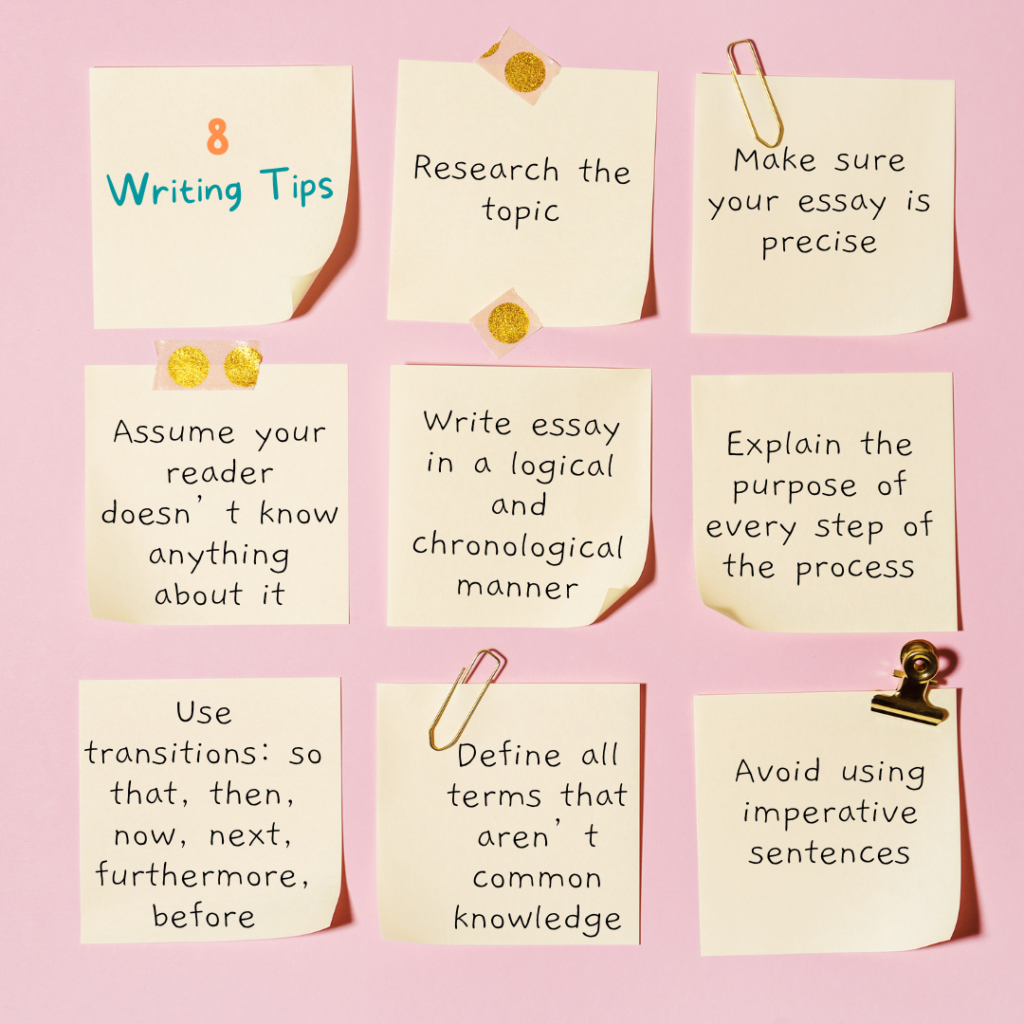
While writing the process essay you can imagine like you’re working on a manual (regardless of the topic). The goal of that manual is to explain how some process works for a person who isn’t informed about it. Here are some tips that will help you:
- Before you start writing, research the topic thoroughly and take notes
- Make sure your essay is precise and coherent, but still features details that enhance its quality
- Assume your reader doesn’t know anything about it, otherwise, you’d skip important details because you think others know it already
- Write the essay in a logical and chronological manner, as one step leads to another
- Explain the purpose of every step of the process, the reader wants to know WHY it happens
- Use transitions such as: so that, then, now, next, furthermore, before
- Define all terms that aren’t common knowledge
- Avoid using imperative sentences because your essay would resemble an instruction manual rather than a proper essay
- An easy way to make a great first impression every time
- Becoming a registered nurse
- Breaking from bad habits
- Car manufacture process
- Changing major at college
- How and why to change Facebook privacy settings
- How to become a real estate agent
- How to conduct a census
- How to finish all school assignments and still have time to for fun
- How to get an A without losing your mind
- How to look like a fashionista every day
- How to lose weight in a healthy manner
- How to overcome insomnia
- How to prepare for emergency disasters
- How to quit smoking
- How to take an amazing selfie
- How to train your husky
- Introduction to Bitcoin and how to get started
- Risk management process
- Simple strategy to get over your ex
- Simple tips to play Minecraft
- The budgeting process
- Tips to master League of Legends
- Writing a book review
The process of writing a process essay involves extensive research that is designed to provide the reader with a comprehensive understanding of the topic. Therefore, it is important to find a reliable and experienced writer who can write an assignment in a relevant way and add new information to the text.
Most students are used to writing argumentative, persuasive, and other types of papers and process essays may make you nervous, especially if you’ve never had this assignment before. First of all, it’s natural to be nervous. It shows you care! There’s a lot you can do to feel better and complete this assignment successfully. You just need the right tools such as:
Essay Topic Generator
You have the freedom to choose your own process essay topic? That’s fantastic! You can write about anything you’d like, but to come up with your topic quickly, you can use Edusson Magic Essay Topic Generator. The platform comes with thousands of essay topics that are going to inspire you, for sure. Just visit the website, enter a keyword or search for topics based on category or alphabet.
Essay Examples
The secret to a high-quality essay and good grade is consistency and practice. The practice doesn’t just involve writing process essays to sharpen your skills, but reading someone else’s paper at the same time. Why? This helps you identify the strengths and weaknesses of some essays in order to create your paper effectively. You get to avoid common mistakes and focus only on those parts that matter. Edusson Essay Examples is an amazing source of essay examples. It’s impossible not to learn or feel inspired when you have hundreds of essays to read. Essay Topic Generator Look for topic View more
Essay Checker
After you finished writing the essay, you need to edit and proofread it. Some students prefer doing everything on their own, but the problem is that many mistakes are overlooked. Now it doesn’t have to be like that. Essay checker called Robot Don enables you to analyze and submit 100% error-free paper. Robot Don evaluates plagiarism, sentence structure, readability, word choice, the frequency of words used, and other aspects of your process essay.
Essay Writing Service
Edusson essay writing service is ideal for students who want to have a custom-made essay sample and for those who don’t have enough time to write it on their own. An amazing team of skilled, experienced, and talented native English speakers is here to help you out. All you need to do is to make your order and choose the writer. Edusson is fully transparent and all essays are written from scratch.
Essay Editing Service
Essay editing service at Edusson is ideal for students who wrote the process essay (or some other paper) and just need help with the editing and proofreading process. Edusson gathered a team of talented editors and proofreaders who make sure your essay has no typos and grammar mistakes while improving style, formatting, and organization, among other things.
Related posts:
- How to Write an Abstract for a Research Paper
- How to Write a Cause and Effect Essay
- How to Format Essay. Example MLA, APA Essay Format
- Best 25 Travel Blogs for Students 2023
Improve your writing with our guides

Writing a Great Research Summary and where to Get Help on it

How to Write a Synthesis Essay

How to Write Essay or Motivation Letter for Internship
Get 15% off your first order with edusson.
Connect with a professional writer within minutes by placing your first order. No matter the subject, difficulty, academic level or document type, our writers have the skills to complete it.
100% privacy. No spam ever.

How to Write a Process Essay?
18 June, 2020
14 minutes read
Author: Tomas White
What is a “process essay”? What makes it different from dozens of other papers you create on a daily basis? What are its main components and what the main goal of this type of writing you need to bear in mind? If you're looking for answers to these questions, you're in luck! You can get them all from our academic guide on how to write a process essay.

Composing a process essay can be rather complicated especially if you are not familiar with this type of writing and do not know what pitfalls and specifications to pay attention to.
That is why our custom essay writing service has created this guide to help you tackle this task. We will answer all these questions in our article below and even provide you with great process essay examples and topics you can write on to stand out. So, if that sounds like something you need right now, read on: we are here to help and equip you with knowledge!
But first things first. Since it is impossible to create an excellent process essay without crystal clear understanding of the term, we will start with the definition. So, let’s dive in!
What is a process essay?
A process essay is commonly written either to explain how something works or to guide a reader through the process of completing a particular task, states the process essay definition.
Process essays also go under the “How-to articles” title and aim to teach the target audience how to achieve certain goals or complete specific assignments.
So, look at it like this. In case of “How to quit smoking” process essay, your primary goal is to provide several helpful ways of quitting this habit. These might be evidence-based recommendations if you have experience in this area, or simply common sense ideas you found while conducting your research.
Now that you realize what you will be working with, let’s look into different types of process essays and practical ways to compose them. Our essay writing guide will walk you through the process essay writing step by step.
Types of process essays
There are two main types of such papers: the ones that explain how something works , and those that show you how to complete a particular task .

1. How to do something.
Though it sounds quite self-explanatory, we’d like to emphasize the importance of clear instructions in case you are writing a process essay.
Your readers must be able to follow your guidance and complete each step successfully. So, split the process into small steps, keep it short and to the point at each stage of crafting a process essay.
For instance, in a “How to quit smoking” process essay , you can split the whole process into seven steps:
- Choose a date for a quit day;
- Imagine life without cigarettes and expect it;
- Have one last cigarette as a “Goodbye!”;
- Be among people to support you;
- Keep your goal in perspective not to give up;
- Don’t fall for substitutes;
- Be accountable.
2. How something works.
By contrast, this is an informative type of writing that aims to achieve one goal – explain the principle of work behind some process. Unlike the mentioned above type, this process essay type does not encourage a reader to take an action and do something step by step.
However, you must make sure that by the end of your essay, the audience will know for sure how something functions.
As an example of this type of a process essay, let’s see how an earthquake happens .
- First, the energy within the earth core builds up due to various moves in the earth crust;
- The energy level grows up and causes tension in the tectonic plates;
- After some time, the pressure radiates outwards by moving the plates from each other;
- The seismic waves shake the earth as they get from the core of the earth to the surface;
- That is when the earthquake takes place.
Before we go any further, let’s look at another example. In case of “How to prepare for a vacation” process essay, your task is to compose a few steps that your readers can take when getting ready for their vacation. In other words, you are describing how to do something.
Meanwhile, “What happens to your brain when you sleep” process essay is merely an explanation of the principle. In it, you are not encouraging readers to take any actions whatsoever. So, here is the fundamental difference.
How to write a process essay?

Getting started with process essay writing
When developing a process essay outline, take some time to answer the following questions:
- Who is your target audience? How deep is their knowledge of the subject? The complexity of your essay depends on their skills level. Thus, for instance, when explaining to your peers how to stretch a dollar to see the world, you can use basic terminology and examples they can relate to. However, your vocabulary should be way more sophisticated if you are writing a process essay on how to improve the overall quality of higher education in your state to the City Council.
- How can you divide the process into small steps? You do not want to bore your audience to death with unnecessary details in a process essay. Yet, you cannot afford to skip valuable steps if they are crucial to the overall understanding of the subject of your process essay. So, try to find the golden cut and figure out the most suitable amount of steps.
- What sources will you use for the task? It goes without saying that you can only use reliable sources to support your argument in a process essay. These sources should be all mentioned in the end of your essay. And remember about proper in-text citation styles. Read the materials carefully and take only the information that will add value to your essay and helps make it shine.
How to write a process essay outline
Finally, let’s look into the process essay structure. Needless to say that you must start with something that will grab readers’ attention, or in other words, “a hook.”
It is true for any essay, and process essay writing is not an exception.
The structure of your essay regardless of the process essay topics should consist of:
- A powerful introduction.
- Main body paragraphs.
- An interesting conclusion.
Related Post: Essay outline | Research Paper outline
Sounds simple, yet there are several things you should not forget about process essay writing.
How to write an introduction to a process essay
Once you compose a hook, mention why you believe that readers should use your approach to solve a problem even though there are dozens of other ones. We know two effective ways to achieve this in your process essay:
- Show how much time this task will take . People don’t have all the time in the world to tackle just this one task. So, you’ll really help them by stating how much time completing something using your approach will take and underline that with your approach described in a process essay it will take less time than if they opt for a different one. “Writing can be tough, especially if you always felt that it is not exactly your suit. However, Michael D. Pollock, a credible expert in this area, has recently presented 10 effective tips that will help you learn writing fast and make you able to craft a 1000-word article in 30 minutes. So, keep reading to find out how you can write this fast too.”
- Introduce your audience to the historical background of the approach (if any) you’re using in a process essay. Let them see the roots of your solution. Here is what a good introduction of a process essay should look like: “Giving a speech with lots of eyes concentrated on you is not an easy task. No wonder so many students dread this task. However, speech can be a powerful tool, and we can teach you how to give them right. Steve Jobs is known as one of the best public speakers of our time. People were sitting on the edge of their seats when he spoke. And we’ll teach you how to grab attention like he did using just five simple tricks he applied.”
At last, compose an engaging thesis of a process essay. Many students consider it a scary part. But it all goes down to this.
Your thesis statement should reason why your way is the best and why readers looking for answers should search no more and give your solution a chance.
It’s easier than you think. Here is a good thesis statement example:
“With more than 580 million tons of household waste produced all over the world, Every tiny effort you make to become eco-friendly counts. And if you don’t want to spend extra money on sustainable products but want to save the environment, use our guide on ten simple eco-friendly steps you can do daily without even noticing it!”
This is what a thesis statement for a process essay on how to be eco-friendly would look like. Yours can be different, but you get the idea!
How to plan main body paragraphs
- Dedicate one body paragraph to one point you want to bring to light.
- Provide enough details on each step including the ultimate goal of this step and reasons why this method was chosen for its achievement.
- Keep it short and to the point.
How to write a conclusion
Now is that time you reminded the readers about the purpose of a process essay, reasons why you chose this particular approach, and briefly mentioned steps needed to accomplish the task.
Besides, you can call your audience to action but only in case you are writing an essay that shows how to do something. Otherwise, it will be inapplicable.
Finally, help them set their expectations right: what results can they count on in the end? How long will it take them to achieve those results after reading your process essay and applying its tips?
How to use transition words in a process essay
Transition words can help you create a seamless reading experience. You can take readers smoothly from one step to another. And what is more you can help them immerse into the process!
Therefore, begin each new paragraph with a transition word, add one in between examples you provide, and summarize your instructions with them, too.

Think of transition words as of bridges that connect paragraphs and sentences. They make smooth communication between the two possible. And with them in your process essay, no reader feels irritated or frustrated with your writing style, as they have to stumble upon every other sentence in your piece.
Good process essay topics
It is not enough to just know the theory to create a good process essay. One should also come up with a topic that will be both interesting and useful to his readers. Here’s a list of our suggestions on process essay ideas:
- How to choose a perfect future career.
- How to survive college and stay sane.
- How to eat healthy on campus.
- How to balance your social and academic life.
- How to pay out a student loan while still at college.
- How to improve your public speaking skills.
- How to see the world with only $100 in your pocket.
- How to learn a foreign language.
- How to renovate your apartment and not go bankrupt.
- How to start your own business.
- How to prepare for your first interview.
- How to get volunteers to help you clean the neighborhood.
- How to write a life list.
- How to set boundaries in the relationship.
- How to study overseas for free.
Related Posts: Argumentative essay topics | Compare&Contrast essay topics
Process essay writing tips
Wrapping up, we would like to introduce you to a couple of vital recommendations on process essay writing:
- Your process essay subject cannot be too broad or too narrow. Look out for the golden cut!
- Introduce your readers to possible complications of the process. After all, forewarned is forearmed.
- Create a short vocabulary your audience can use in case they are not familiar with the terminology essential to the general understanding of the process essay in question.
- Develop a list of resources your readers will need as they deal with certain tasks. This way you will have them prepared to put your recommendations to action right away.
- Always write a process essay using Active Voice!
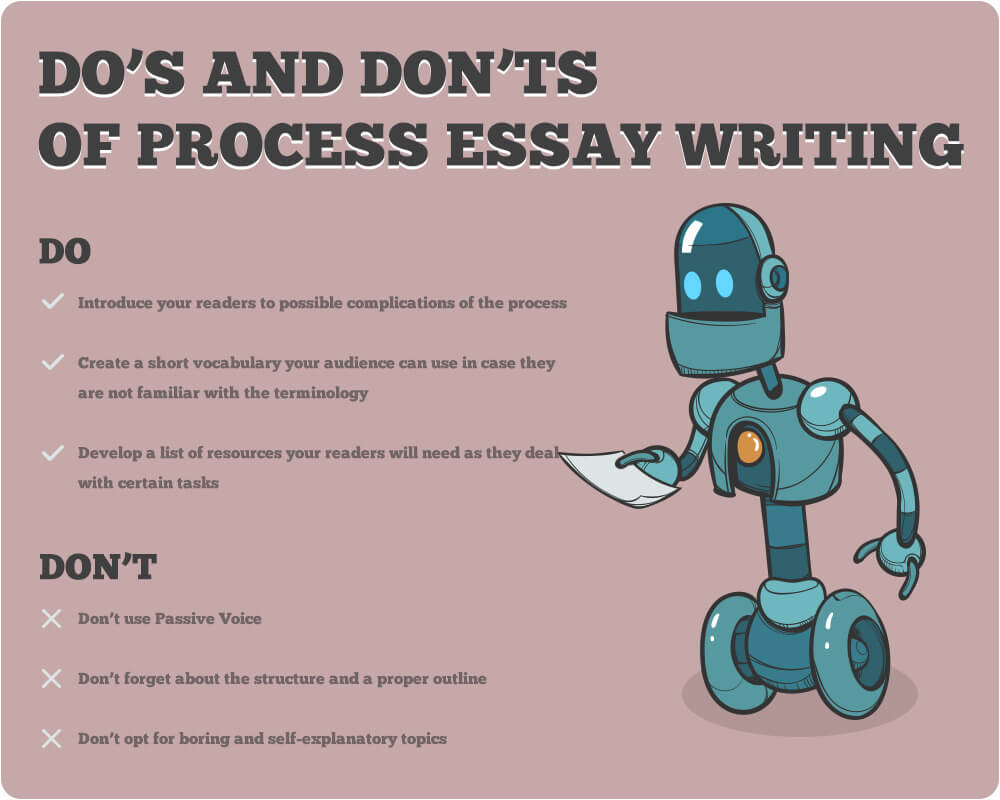
Need help with your process essay writing? Handmadewriting is here for you to help. Drop us a line to get our professional essay writers to develop an excellent piece for you!

A life lesson in Romeo and Juliet taught by death
Due to human nature, we draw conclusions only when life gives us a lesson since the experience of others is not so effective and powerful. Therefore, when analyzing and sorting out common problems we face, we may trace a parallel with well-known book characters or real historical figures. Moreover, we often compare our situations with […]

Ethical Research Paper Topics
Writing a research paper on ethics is not an easy task, especially if you do not possess excellent writing skills and do not like to contemplate controversial questions. But an ethics course is obligatory in all higher education institutions, and students have to look for a way out and be creative. When you find an […]

Art Research Paper Topics
Students obtaining degrees in fine art and art & design programs most commonly need to write a paper on art topics. However, this subject is becoming more popular in educational institutions for expanding students’ horizons. Thus, both groups of receivers of education: those who are into arts and those who only get acquainted with art […]
How to Write a Great Process Essay
Otherwise Known as a How-To Essay
CSA-Archive / iStock Vectors / Getty Images
- Writing Essays
- Writing Research Papers
- English Grammar
- M.Ed., Education Administration, University of Georgia
- B.A., History, Armstrong State University
How-to essays , also known as process essays, are much like recipes: They provide instruction for carrying out a procedure or task. You can write a how-to essay about any procedure that you find interesting as long as your topic fits the teacher's assignment.
Start by Brainstorming
The first step in writing your how-to essay is brainstorming. Here are tips to help you:
- Draw a line down the middle of a sheet of paper to make two columns. Label one column "materials" and the other column "steps."
- Write down every item and every step you can think of that will be needed to carry out your task. Don't worry about trying to keep things in order yet. Just empty your head.
- Number your steps on your brainstorming page. Just jot a number beside each item/step. You may need to erase and scribble a few times to get the order right. It's not a neat process.
Create an Outline
First, determine the format required for your essay; ask your teacher if you are unsure. Your essay could contain a numbered list (like the one in the previous section), or it could be written as a standard narrative essay. If you are instructed to write a step-by-step without using numbers, your essay should contain all the elements of any other essay assignment, including an:
- Introductory paragraph : the section that identifies the topic , arouses interest, and prepares the audience or readers for the development of the thesis
- Body : the part of an essay that develops the main idea
- Conclusion : the sentences or paragraphs that bring the essay to a logical end
Regardless of the essay format—whether your teacher allows for numbered paragraphs or sections or simply wants you to craft a narrative report—your outline should center on these three areas.
Creating the Essay
Your introduction will explain why your topic is important or relevant. For example, your paper about "How to Wash a Dog" would explain that dog hygiene is important for your pet's good health.
- Your first body paragraph should contain a list of necessary materials. For example: "The equipment you will need depends somewhat on the size of your dog. At the very minimum, you will need dog shampoo, a large towel, and a container large enough to hold your dog. And, of course, you will need a dog."
- The next paragraphs should contain instructions for following steps in your process, as enumerated in your outline.
- Your summary, or conclusion, explains how your task or process should turn out if it is done correctly. It may also be appropriate to restate the importance of your topic.
Topics to Write About
You may believe that you are not expert enough to write a process essay. This is not so. There are many processes that you go through every day that you can write about, including:
- How to make a perfect paper airplane
- How to dye your hair
- How to wear makeup
- How to survive a weekend with your family
- How to play basketball
- How to play (a popular video game)
The goal in this type of assignment is to show that you can write a well-organized essay and clearly explain to the reader how to do what you are instructing.
- 6 Steps to Writing the Perfect Personal Essay
- How to Write and Format an MBA Essay
- How To Write an Essay
- List of Topics for How-to Essays
- Strategies for Writing a 20-Page Paper
- Write an Attention-Grabbing Opening Sentence for an Essay
- How to Write a Response Paper
- How to Write a Narrative Essay or Speech
- How to Write an Instructional Outline
- What Is Expository Writing?
- How to Write a Great Essay for the TOEFL or TOEIC
- Tips on How to Write an Argumentative Essay
- How to Structure an Essay
- The Five Steps of Writing an Essay
- Writing a Descriptive Essay
- The Introductory Paragraph: Start Your Paper Off Right

- Customer Reviews
- Extended Essays
- IB Internal Assessment
- Theory of Knowledge
- Literature Review
- Dissertations
- Essay Writing
- Research Writing
- Assignment Help
- Capstone Projects
- College Application
- Online Class
How to Write a Process Essay: A Complete, Step-by-Step Guide
by Antony W
February 16, 2023
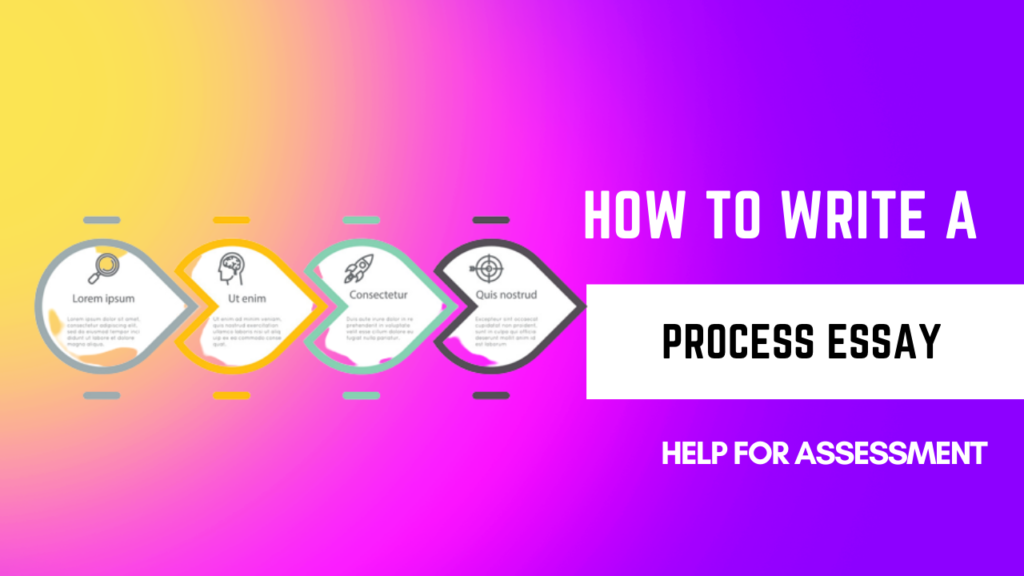
A process essay, also known as “how-to-essay”, is a common type of paper that informs the reader how something is done. Being able to write a process essay is about talking the reader through a set of instructions or step-by-step guide on how to do something such as performing an experiment, preparing a meal, or carrying out a specific process.
Writing a process essay should involve enough details to lead the reader successfully to the desired goal.
You need to follow the step-by-step process until the reader has achieved what you’re leading them to do.
Any missteps or poor explanations at any point can cause bad mistakes or even ruin the entire project, so process essays need to be highly detailed and instructional.
This guide will show you how to write a brilliant and effective process essay and be sure of that A-grade.
Pre-Writing: Planning Your Process Essay
The first requirement if want to write a good process essay is preparation.
Preparing the small stuff goes a long way in ensuring you deliver the best of the report.
Some of the things to look into for an essay that meets expectations include;
Understand the Target Audience
Before you start writing, you have to understand your target audience and their expectations from the essay.
The target audience determines the language to use and the general complexity of the essay.
Ask yourself about the education level of the audience on the topic. Understand if you have to explain basics for them to understand.
I t’s also essential that you the language and terminologies best suited to the audience.
Create a List of Materials Needed
Anything that involves creating something new will require materials.
The same applies to writing a process essay which details how a thing is done. Before you start writing, create a list of all the materials and tools the reader will need for the whole process.
Place each item either in the order of use or importance. The more impactful or useful a tool is, the earlier it comes on the list.
Create an Outline
Once you have understood your audience and listed the needed tools, it’s time to note what you want to include in the content.
It is easy to forget important things that you need to include in your essay, but an outline creates a structure that you can flesh out with details.
Note down every step, detail the important all the important steps, and try to make your ideas flow clearly .
You don’t have to go into a detailed explanation at this point. Just have the steps down with the important tools.
Structure of a Process Essay
Introduction.
The introduction is where you get to draw in the reader and get them interested in the essay.
You can talk to them about why the particular process they are about to undertake is important without jumping ahead of yourself.
You can also mention briefly what the essay will cover, thus creating anticipation for what is to come.
Another tactic is to d raw the reader’s interest by giving some historical background of whatever you are working on. It also helps to refer to the timeframe so that they prepare well in advance.
Body Paragraphs
The body paragraphs are where you introduce the step-by-step guide to your the readers.
Let the readers understand why they each step in the process is important and why they need to take it instead of alternative methods.
The length of the paragraphs depends on the complexity of the whole process. Every section should have enough details such that the reader would complete the process properly.
Be sure to mention what equipment and tools will be necessary for the procedure. Also, let the reader know of possible troubles and other difficulties to expect during the process.
Ensure the smooth flow of everything by using transitions. The transitions make the Essay easy to read and follow. Use terms like then, so that, next, now, and others.
Your process essay's conclusion is where you can go through the expected results of the process.
It summarizes everything about the guide and provides the reader with a reinforcement of the procedure’s significance.
Explain to the readers the result.
State what it looks like and what follows, whether there are other processes or its final. Ensure your read is accomplished by the end of the essay.
Process Essay Writing Tips
There is more to writing a process essay than identifying the audience and using the right format.
1. Focus on Simplicity
As a guide on doing something, most probably for the first time, a process essay should be easy to follow and understand.
Use simple language with clear directions on how to perform all the processes.
The choice of words and the construction of sentences must meet the reader’s understanding.
2. Choose the Right Topic.
Your choice of topic is crucial when it comes to process writing.
Choosing a technical topic might not resonate with the audience, as you can also have little to write about.
Common issues are also hard to write about as you never seem to be helpful. Look for the readers’ probable needs and solve them.
3. Proofread the Essay
Once you are done writing, revisit the whole of your work to ensure everything is in place. Revise the work with the reader in mind.
Ensure the language resonates with the target audience. Pass the work through checkers for plagiarism-free work .
Ensure your work is well detailed with all the necessary guidelines. Include all the steps while you eliminate anything unnecessary.
Only hand in your work once you have achieved a desirable result.
4. Seek Help For Your Process Essay Assignment
No matter how much you have mastered the art of writing a process essay, you can never be all-knowing.
Do not shy from seeking help from a friend or professional to help you through the writing and proofreading.
Working with a professional team like Help for Assessment helps in creating high-quality work for assured high grades. Our essay writing experts are experienced in delivering top-notch papers on various topics.
Related Reading
- This Guide Will Help You to Write an Opinion Essay
About the author
Antony W is a professional writer and coach at Help for Assessment. He spends countless hours every day researching and writing great content filled with expert advice on how to write engaging essays, research papers, and assignments.

How to write excellent Procedural Texts
WHAT IS A PROCEDURAL TEXT?

A procedural text instructs your audience on how to complete a specific task. Generally, this falls into two categories, how to make something and how to do something.
The purpose of a procedural text is to provide sequenced information or directions so that people can successfully perform activities safely, efficiently and appropriately.
In some parts of the world, you may encounter procedural writing called a Process Analysis Essay. This title gives students a greater understanding of their purpose of analyzing a process and writing it up as a simple procedure to be followed by the reader.
Having a good grasp of this type of genre writing has multiple possible real-life applications for our students. Luckily for such an important genre, procedural texts are one of the more accessible genres to teach and successfully produce as a student.
As a straightforward nonfiction genre, procedural texts are often easier to grasp for those students who don’t possess a natural affinity for writing than some of the more creative writing genres. In this guide, we will share a series of criteria that will ensure that even struggling students can produce coherent and successful procedural texts with confidence.
A COMPLETE TEACHING UNIT ON WRITING PROCEDURAL TEXTS
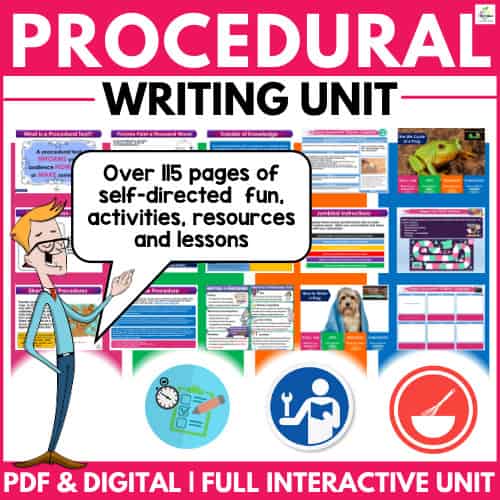
This HUGE BUNDLE offers 97 PAGES of hands-on, printable, and digital media resources. Your students will be WRITING procedures with STRUCTURE, INSIGHT AND KNOWLEDGE like never before.
TYPES OF PROCEDURAL ESSAY

- Directions – How do I get somewhere? Very specific instructions, including location names and titles. Formal language is required, and the addition of a map will make your instructions so much easier to understand.
- Instructions – How do I do something? Your language must meet the needs of your audience, and you may need to include a diagram if there are complex elements to complete.
- Recipes – How do I cook something? Recipes are universal texts. There is a very clear expectation of the audience, so never stray from the essentials. Ingredients, method and a few visuals are essential.
- Rules for games – How do I play this? Be conscious of your audience and write in a style and language they will understand. You are almost guaranteed to require visuals in this style of writing.
- Manuals – How do I operate this? Are there any warnings I need to be aware of before proceeding? Be very specific in your explanation.
- Agendas – What are we doing? When are we doing it? Who is responsible?
PROCEDURAL AND EXPLANATION TEXTS – WHAT’S THE DIFFERENCE?

An explanation text is similar to a procedural text, which can often be confused. However, an explanation text explains the how and why behind a process, such as
- What causes a Tsunami?
- Why are our rainforests disappearing?
- The process of making aluminium.
A procedure generally instructs the audience on how to make or do something, such as a recipe. Although they have similarities, they are two very distinct writing tasks.
In short, an explanation text is for the THINKER in us as it takes the time to EXPLAIN all the background questions that may arise, whereas a procedure is for the DOER in us, providing a highly efficient set of instructions that exist just to get a PROCESS completed.
STRUCTURE AND FEATURES OF A PROCEDURAL TEXT
Procedural text structure.
HEADINGS Titles indicate the goal or aim of your procedure.
SECTIONS Keep everything organised and in order.
SUBHEADINGS Subheadings such as materials, what to do next, warnings indicate the stages of the procedure.
SEQUENCE Everything is organized in the sequence it is to occur and each new step must begin on a new line.
PROCEDURAL TEXT FEATURES
VOCABULARY Use technical and specialized terms in a procedural text. Don’t dumb things down.
TENSE Always write in timeless present tense
FLOW Use connectives and conjunctions related to time to indicate the chronological order of the actions.
DETAILS Details are important in a procedure. Assume very little.
VISUALS Greatly enhance a procedural text and reinforce technical instructions. Maps, diagrams and photos are essential.
LANGUAGE FEATURES OF A PROCEDURAL TEXT
Given the broad range of forms, a procedural text may take, we should not expect that all the structure and features outlined will apply equally to each type of text. However, the following is some valuable general advice for students to bear in mind when they are considering the language registers of their text.
Procedural texts are one of the few writing genres that regularly use the second person pronoun that addresses the reader in a general way. Often too, this ‘you’ will be implied through the use of imperatives at, or near, the beginning of sentences.
Given the nature of these types of text, the simple present tense is the preferred tense for this type of writing . In this regard, it offers an excellent opportunity to focus on verb work, especially on imperatives. These command words, or bossy words, such as cut , take , and hold, are often used to give orders for readers to follow as they move step by step through the process outlined in the text.
This is a nonfiction genre, which should be reflected in the choice of language. There is little to no place here for flights of imagination or figurative turns of phrase. Students should stick to plain, straightforward sentence structures and word choices. They should include detailed factual descriptions of things that will enhance the reader’s understanding; shape, size, color, and the amount should be included where improves understanding.
Sentences should also provide detailed information on how to perform each step in the process outlined. For example, remove carefully rather than simply remove – when care is necessary for satisfactory performance, make sure it is stated explicitly.
Actions should be outlined sequentially, and time connectives can be used to help organize the necessary steps chronologically. For example, the use of adverbial time words, such as: first, second, before, then, and after. Encourage students to focus on answering the questions of where and when of each action they instruct the reader to follow.
HOW TO WRITE A PROCEDURAL TEXT

Now that we have covered the ‘why’ of procedural texts, it’s time to get into the how. Looking at the graphic above, you will see the four pillars of procedural writing to be addressed. Use our free writing template below to help organize your thinking most efficiently and make sure you check out our tutorial video for further clarification if required.
Prewriting Considerations
- What is to be done or made? What is the aim or goal? What might your title be?
- What is needed to complete this? Materials, ingredients, tools and so on.
- In what order should things be done? What are the steps in the process? What is the best way to organize and present them?
- What will you add to your written text to help the audience understand better? ( diagrams, illustrations, pictures etc. )
Take a moment to answer these questions, as a little bit of planning will save you a whole lot of confusion and stress when writing your procedural essay.
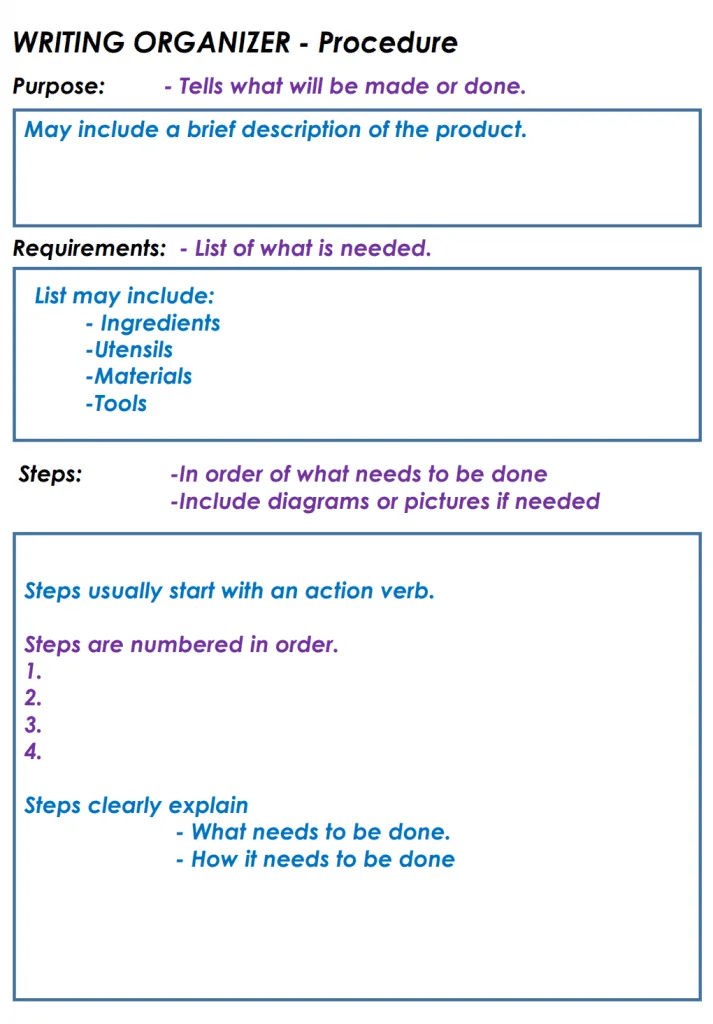
1. Purpose / Goal / Aim
This component addresses the what of the piece. It will refer to what is to be done or made. Very often, too, this will provide for the title of the text itself. Often this will be stated in the form of a ‘how to’ sentence or the name of the thing to be made itself. With more technical procedural texts, titles may be more generic and standardized, such as simply Operating Manual or User’s Guide or, in its most basic form, Instructions .
To help your students understand the importance of the title and its relationship with the goal of the text, provide them with a set of procedural texts with the titles removed. In groups, have them brainstorm a variety of titles for the text. When they are finished, reveal the original title of the text and compare it with the suggestions made by the group. Soon they will start to see the pattern evolve, which will help them when they come to produce and name their own procedural texts.
2. Materials / Resources
Usually done in the form of a list, this component may also be titled Materials , Equipment , Ingredients , Items Needed etc. and is pretty self-explanatory. This component comprises a list of things required to complete the procedure outlined in the text. For a recipe, this will obviously include things like ingredients but may also include things like the appliances and tools required to follow that recipe to completion. For flat-pack furniture, for example, items like a screwdriver or spanner, the glue will form this section. Science experiment procedural texts will include apparatus such as Bunsen burners, test tubes, litmus paper etc. Regardless of the specific purpose of the text in question, the resources listed in this section will usually be presented in the order they will be used, as far as this is relevant or possible.
This is the heart of the procedural text as it outlines step-by-step the methodology to follow in the procedure itself. Again, the title of this section of the procedural text may vary depending on the specific type of writing it is. Longer user guides and instructional manuals will have a complex and extensive list of steps to follow that will employ subtitles and subsections to explain micro-processes within the wider procedure being described. More straightforward texts, such as recipes, will be much less complex in structure. It is essential to encourage students to think very logically about the process they are attempting to outline in their writing. Too often, students write themselves into corners as they try to describe complicated procedures while struggling with the technical difficulties of constructing grammatically sound sentences. A good rule of thumb for student writers is to use many short and simple sentences when writing about complex ideas. We will talk more about this aspect when we discuss language features in greater detail.
4. Conclusion
The conclusion of a procedural text offers guidance to the reader on how they can evaluate the success of the procedure that has been followed. This may take the form of, for example, a description of the completed meal for a recipe text or a description of the assembled furniture in a flat-pack instruction guide. Depending on the type of text in question, illustrations can often be used to reinforce what a successfully followed procedure will look like.

USE HEADINGS TO KEEP YOUR READERS ON TRACK
Recipe – Sub Headings (Example)
- Ingredients
- Serving Suggestions
Science Report – Sub Headings (Example)
- Aim / Hypothesis
- Method; Results
THINK LOGICALLY AND ASSUME VERY LITTLE.
The challenge in writing an excellent procedural text is to deliver your instructions logically. Ensure your instructions are straight to the point and that you, as the author understand what you are trying to achieve. You really want to answer three questions to your audience.
- What will I need to complete this task?
- What do I have to do to complete this task?
- How will I know if I completed the task correctly?
Ensure you also clearly understand your audience, as this will have a significant impact on the language you use.
ILLUSTRATIONS: PICTURES PAINT A THOUSAND WORDS

It can often be challenging to describe actions in words – even for accomplished writers. Casting a quick eye over the sports pages of the newspaper will quickly reveal the importance of the visual in relaying information.
You’ll find photographs that convey the commitment and sacrifice of the athlete to their sport far better than most of us can convey with our meagre language skills. The old newsman’s adage A picture paints a thousand words can be just as accurate for procedural texts. But photographs aren’t the only visual means of reinforcing the written word in procedural texts.
Depending on the nature of the text, employ diagrams, schematics, tables, and even cartoons! As with the written text, these images will often be ordered sequentially along with the corresponding text and usually labelled or accompanied by a caption.
HOW TO WRITE A GREAT PROCEDURE VIDEO TUTORIAL (4:30 mins)

TIPS FOR WRITING A GREAT PROCEDURAL REPORT
Procedural text graphic organizer template.
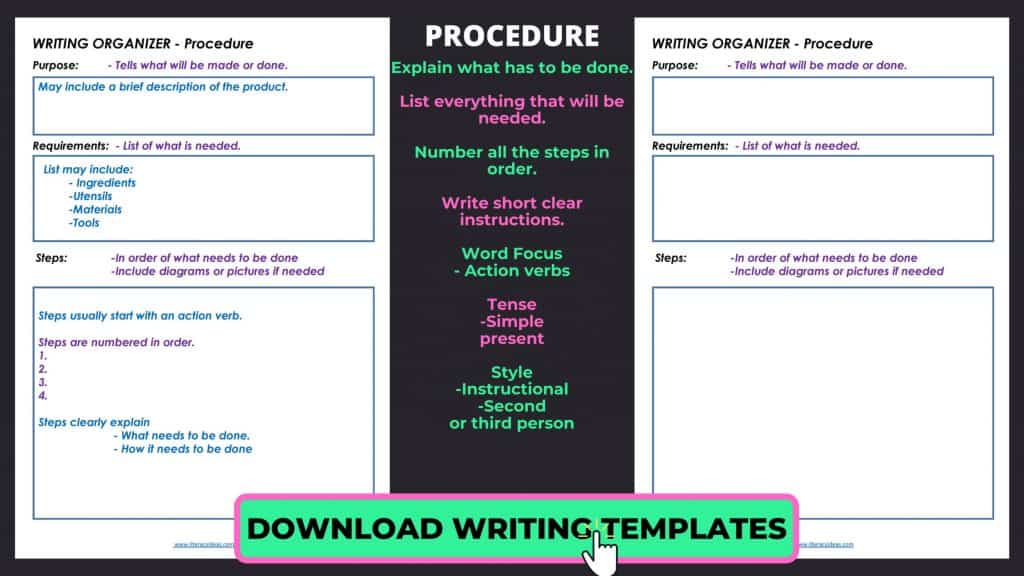
Procedural text ExampleS (Student Writing Samples)

Below are a collection of student writing samples of procedural texts. Click on the image to enlarge and explore them in greater detail. Please take a moment to read the procedures in detail and the teacher and student guides highlighting some of the critical elements of writing a procedure before beginning.
Please understand these student writing samples are not intended to be perfect examples for each age or grade level but a piece of writing for students and teachers to explore together to critically analyze to improve student writing skills and deepen their understanding of procedural text writing.
We would recommend reading the example either a year above or below, as well as the grade you are currently working with, to gain a broader appreciation of this text type.
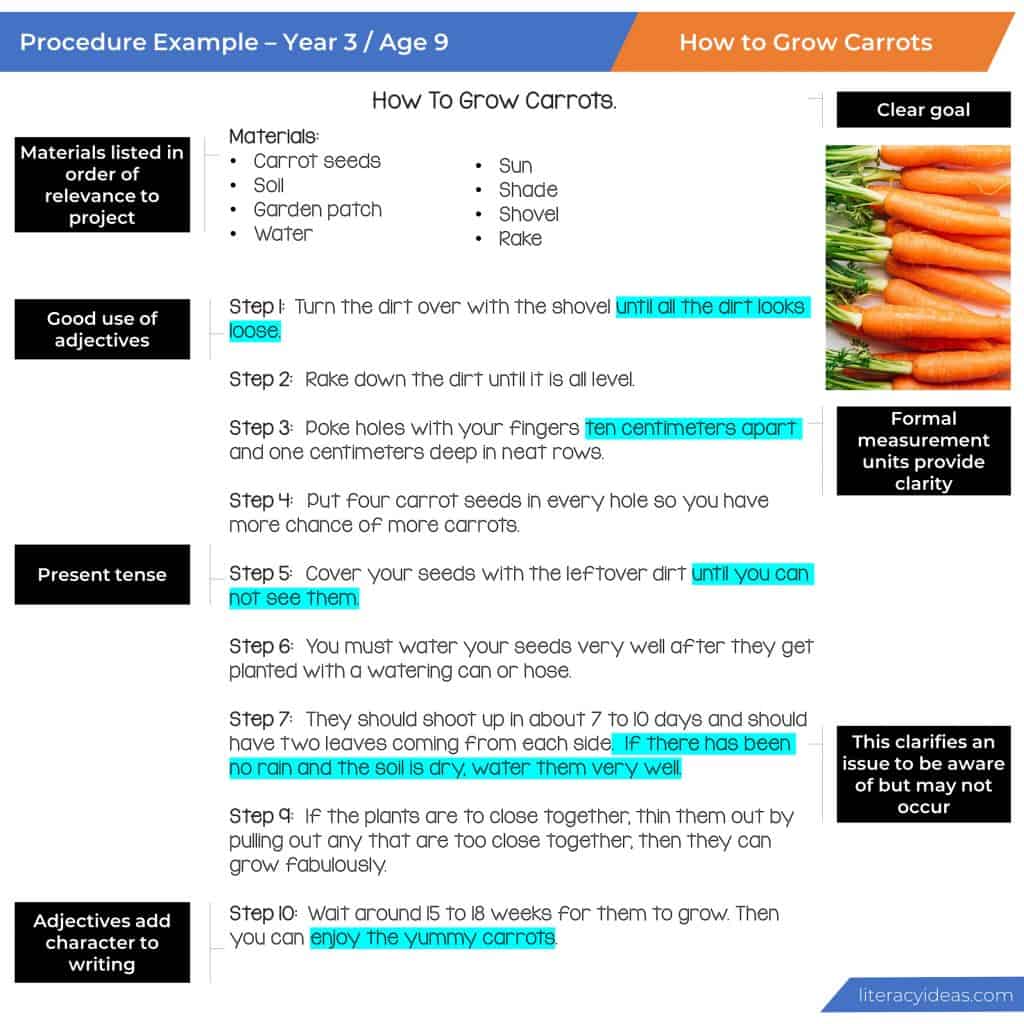
PROCEDURAL TEXT WRITING PROMPTS
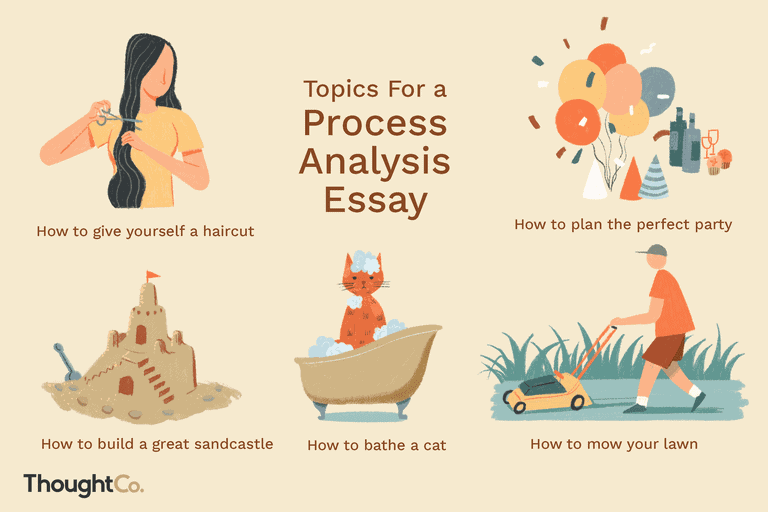
Teaching Resources
Use our resources and tools to improve your student’s writing skills through proven teaching strategies.
TEACHING IDEAS for PROCEDURAL TEXTS

Be sure to check out our guide to mastering procedural writing in a single week here. And if you are looking for an instant, no prep fantastic teaching resource procedural texts, look no further than this unit on TpT.
One of the things that make procedural texts an accessible writing genre for our students is one of the things that can also make it an uninspiring genre for students to engage in, that is, its factual, straightforward nature. There is a reason why we don’t sit up all night reading user manuals! Entertaining the reader is not the priority of a procedural text, and it shows.
So how can we spark the interest of our students strong enough to carry them through the process of producing a completed text? One way is to get creative with the titles of the procedural texts we ask them to produce. For example, if we teach recipe writing, your students may be marginally less than thrilled to be tasked with writing a recipe on ‘How to Make Scrambled Eggs’. Why not add a dash of imagination to it? How about ‘How to Make the Most Disgusting Sandwich in the World’ – now, isn’t that a little more interesting? Sure, no one will actually make the end product – who wants a toenail clipping sandwich garnished in boogers anyways? But, the student will still have to organize their text to the same structures outlined above. They will have to consider the same language features and measure the success, or otherwise, of their writing to the same criteria of a more deadpan procedural text topic.
Another way to ensure student engagement in the writing of procedural texts is to set them a topic that appeals to their own interests specifically. It may be a sporting interest – How to Take a Penalty Kick , a musical one – How to Tune a Guitar or an arts and crafts based task – How to Make a Paper Airplane . All that is needed is a topic that interests the student and one that they have competency in.
Even if the student chooses something they do not have competency in, and if it isn’t too complicated, they may wish to take the learning opportunity and research something new to write a procedural text about based on what they learn. This can be great for longer-term projects and can also be linked to things they have learned in other subjects at school. Reconstructing their learning in this manner offers a wealth of hidden assessment opportunities for the teacher, providing valuable information to inform future planning and provide data for recording and reporting.
PROCEDURAL TEXT SUCCESS CRITERIA AND ASSESSMENT TOOLS
Early in this guide, we outlined the four main components of a procedural text, the last of which was the conclusion. The conclusion, we stated, “offers guidance to the reader on how they can evaluate the success of the procedure that has been followed.” Likewise, in teaching our students to produce procedural texts, we must offer them a means to assess whether or not they have completed the task successfully themselves. One way they can achieve this is by using a Success Criteria checklist. The features students must include can be listed in a column to the left, and in the right-hand column, students can check if they have the feature or quote an example as evidence from their text. For example:

For students to successfully produce their own pieces of genre writing, they must internalize the features of that writing genre. To do this, they must be exposed to successful and unsuccessful examples of the genre to develop a good critical sense. Peer assessment is a suitable means of achieving this. Have your students exchange their work with each other, and, using a template similar to the example above, they can assess each other’s work. This is an excellent method to give your students the practice required to internalize the criteria for successful procedural writing. Varying the number and the complexity of the items on the criteria checklist is a convenient means of catering to different ages and abilities too.
The Proof is in the Pudding
A more practical means of assessing the effectiveness of a procedural text is for students to swap their writing with one another and then carry out the instructions in their classmate’s text to the letter. If they can correctly perform the task exclusively in response to these written instructions, then the writing has been, at least on a purely practical level, successful. Of course, this method does not account for many technical elements that the teacher will still need to check for, but it can be a lot of fun and an opportunity for the students to share their knowledge and interests with one another.
If At First, You Don’t Succeed…
As I stated in this article, procedural texts are one of the more straightforward writing genres for students to master. That said, however, mastery only comes with focused practice. Though structurally, this genre is relatively easy for students to grasp, there are still a lot of language features to consider and stylistic conventions to adhere to. As well as that, there is considerable variation in the complexity of the various types of procedural texts, from simple recipes all the way to complex user manuals. All this takes considerable practice, so it is essential that students are offered regular opportunities to hone the broad range of skills required to write well. Some of this learning will take place in discrete sessions dedicated to the writing of procedural texts, but many of the skills will be developed while working on general language skills, whether focused on verbs, tenses, punctuation, reading etc., it will be useful to make links to principles in common with the various writing genres as and when they arise.
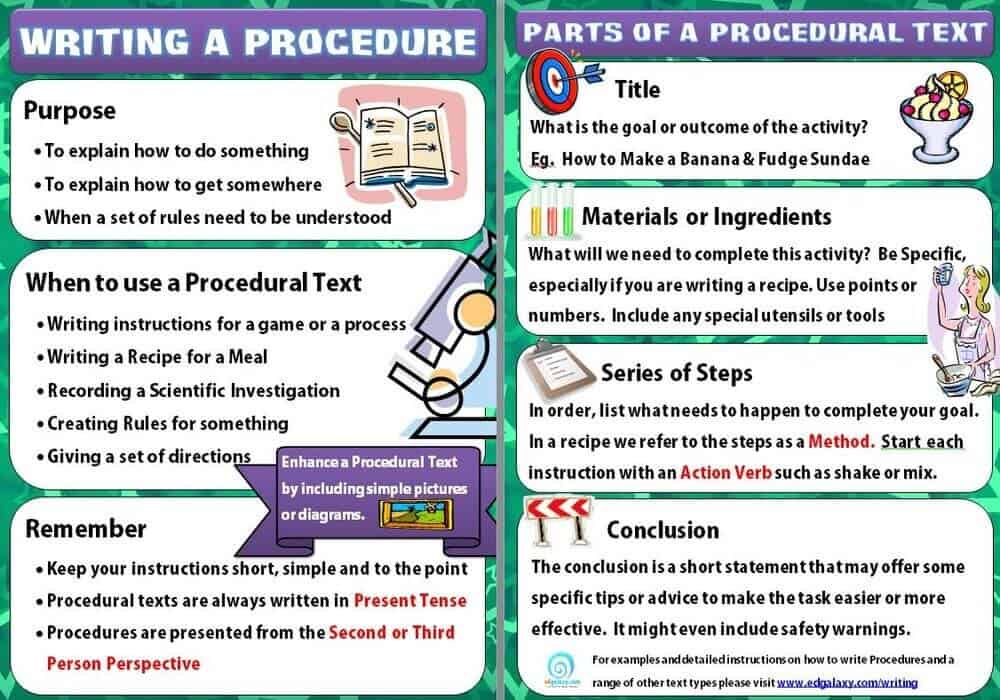
PROCEDURAL WRITING CHECKLISTS

⭐⭐⭐⭐⭐ (92 Reviews)
OTHER GREAT ARTICLES RELATED TO PROCEDURAL TEXTS

5 Procedural Writing Lesson Plans Students and Teachers will Love

The Writing Process

How to Write an Excellent Information Report

How to Write a Descriptive Text

HOW TO WRITE A HYPOTHESIS
- Essay Guides
- Main Academic Essays
How to Write a Process Essay: Useful Tips and Examples
- Speech Topics
- Basics of Essay Writing
- Essay Topics
- Other Essays
- Research Paper Topics
- Basics of Research Paper Writing
- Miscellaneous
- Chicago/ Turabian
- Data & Statistics
- Methodology
- Admission Writing Tips
- Admission Advice
- Other Guides
- Student Life
- Studying Tips
- Understanding Plagiarism
- Academic Writing Tips
- Basics of Dissertation & Thesis Writing
- Research Paper Guides
- Formatting Guides
- Basics of Research Process
- Admission Guides
- Dissertation & Thesis Guides

Table of contents
Use our free Readability checker
A process essay is a type of expository writing that explains a series of steps or procedures to achieve a particular outcome or complete a task. It provides detailed, step-by-step guidelines for the reader to follow.
If you want to understand how to write a “how to” essay, the best solution is to turn for help to the professional academic essay writers with a rich writing experience. Review this article, which contains everything a student should know before writing your process essay.
What Is a Process Essay: Definition
Before learning how to write a process paper of A level, it is critical to define the term. A process essay refers to the type of academic writing which contains a detailed description of the particular process in the shape of the step-by-step guide. This form of essay is popular in business & technical writing. Some of the best examples of process essays include:
- Instruction/owner’s manual;
- User’s guide;
- “How to…” articles;
- Security instructions;
- Recommendations.
Students should test the process themselves before writing an instruction or manual. It would be the best answer to the question “ what is a process essay ?”
Process Essay Outline: Structuring Your Paper
There is not much to say about the process essay outline because structure repeats steps required to complete a certain procedure. Having an outline is helpful in any situation associated with academic writing. Put down every stage in chronological order. Once the student has an outline, they may later add some details depending on the process development to come up with the whole body. Maybe you will ask " How to structure an essay of this type?" The structure of a process outline is common:
- Introduction paragraph (mention the process to discuss).
- Body paragraphs (list the stage and provide details).
- Conclusion (specify what the expected outcome should be + share some success indicators).
The length of a “how to” essay depends on whether the chosen procedure is time-consuming or not. Do not pick something extra fast not to have a few-sentence essay in the end.
Process Essay Introduction
Let’s talk a little about the process essay introduction. It does not matter whether an essay is describing the way to get chocolate out of milk and coconuts, explaining some procedure of vaccination, or interpreting steps required to write a book. It is important to identify the target audience from the start! If it is an average user, avoid difficult terms. In case you write to satisfy the curiosity of advanced users, do not mind including various professional terms to prove your competence in the chosen field. Do not worry about structure. The best thing about this type of academic assignment is that step-by-step process itself provides a student with correct structure. Still, experts recommend having an outline. Would you like to know good ways to start an essay of this type? Start an opening paragraph by determining an analyzed procedure and share personal ideas on why this specific process is interesting & important to observe. Formulate a process essay thesis. It is not necessary to cover history or background of some discussed procedure.
Process Essay Body Paragraph
Do not include any details that do not relate to the process itself. If some required tools & equipment are rare, tell readers some ways to get these resources. Write down warnings about possible safety hazards to prevent readers from falling into trap/injuring. Describing steps alone might be dull. To enrich your writing, add some common mistakes to avoid. And provide helpful tips to make this process simpler & quicker. Main body of a process essay is usually written in chronological order. Add every step in chronological order with the help of clear words. If there are similar steps or those that can be performed at different stages, mention it to acknowledge the reader. To prevent confusing situations/failures, experts recommend subdividing the steps of especially long processes (example: Step 1A, 1B, etc.) Professional hint from essay order experts!
“A good process essay always uses the second person – “you.” It sounds more personal, and readers trust its writer. Be ready to apply a plenty of transitional words & phrases! They make this procedure description logical and clear to every reader. Try to insert different transitions to prevent text from being repetitive. During the process of writing an instruction or manual, do steps described in text to check whether everything works the way it should before offering the same actions to your target audience.” Professor Pryce, academic counselor and online writing tutors at StudyCrumb
Writing Process Essay Conclusion
Let’s see how to end writing a how-to essay. By the end of an instruction, reader/user must be able to repeat provided actions to activate the process or solve some problem alone. If readers cannot do that, it means that writer failed giving clear, correct instructions. How to start a conclusion in an essay ? Do it with some short review of an entire process from A to Z. It will help readers recall what they were doing, how long, and what expected results should be. While body paragraphs provide detailed interpretation of each stage, a conclusion must contain a single short sentence summarizing every step of a process. It should look like an opening sentence of this article.
How to Write a Process Essay: 10 Simple Steps
Process essay writing is not a difficult task. Even though a process essay is easy to write, it is crucial to know the essential steps of writing. Knowing all nuts and bolts will help you write an article quickly and correctly. Below you will find 10 basic steps you should know to write an outstanding process essay. Step 1: Think of some topic you want to write about. What interests you most? What will be useful for your readers? Consider all these questions and create the best topic. Browse our process essay topics we prepared for our users. Step 2: Start your research. Look for some sources that have relevant information. Collect all important data. Step 3: Read sources you collected carefully and analyze information. Make notes when reading and have quick access to needed information. Step 4: Create an outline for your paper. Plan your future paragraphs beforehand. Step 5: Collect all parts of your guide together and think what you may add to the main body. Write body paragraphs. Step 6: It is not a good idea to compose your introduction at the beginning. Start writing your introduction paragraph only after you have main part. Step 7: Don’t forget about a strong hook for your paper. It should be concise, informative, and grab attention of your reader. Step 8: Finally, summarize all points you mentioned in your text and create your conclusion. Highlight the result again. Show readers what they will get after they follow all steps mentioned in your essay. Step 9: After all these steps are done, create a catchy and informative title. It should not only display what your essay is about but also grab your reader's attention and make them want to read your guide. Step 10: Proofread your process essay and edit mistakes. Read your text again, check for typos and grammar mistakes. Make sure it is readable and understandable. Following these steps will help you create a truly brilliant process essay that you will get an A+ for. Buy essays papers to enjoy even higher odds to succeed with your submission.
Helpful Tips on How to Write a Process Paper
While writing this type of academic essay, recall these professional tips & tricks and earn A+!
- Say what you are doing to describe an action. It would be paper’s topic, precise, clear, and educating. Narrow down your topic if it sounds broad. Example: Instead of calling some instruction “How to Install Windows” make it “How to Install Windows 10 on the most recent Asus models (name them).”
- Get ready with outline of an essay , which is structure of your essay.
- Name requirements like resources, equipment, instruments, stuff, skills, and knowledge person will need to complete their process. If more than one person is required, mention it.
- Identify technical & professional terms in text. In case manual explains a procedure based on special, technical knowledge/skills, such as carpentry, it is better to include some definitions of some specific terms readers might not know. If your teacher allows, enrich your essay with images, signs, graphs, and tables to explain some word.
- Each good instruction should contain warnings/cautions. List all possible threats & security hazards. Along with some obstacles readers may face in the process. Use an active voice in this part.
- Finish manual/instruction with an explanation of what person should be ready to obtain once the procedure is over (stress the importance of experiment). It is important to list success factors. Example: “Cooked dumplings should not look tenderized/taste raw.”
- Add images & more techniques so readers follow instructions simpler. For instance, “peach color” may be perceived as various textures by various individuals.”
Interesting Process Essay Examples
Of course, we won’t leave you without a real example of a process essay. Only reading this article may not be enough. Before you start your writing, it is better to look at how other students organized similar works. Here is one of professional how-to essay examples shared by college students.
If you want a similar essay customized to your needs, just say " write my essays " and StudyCrumb will provide tailored assistance. Our writers prepare such orders daily and know how to make your process essay beautiful.
How to Write a Perfect Process Essay: Final Thoughts
As you see, writing a professional essay is not as difficult as you might think. This type of essay does not require some special writing skills or use of high academic language . So following our simple tips we provided in our article will help you create an excellent essay that will guide readers through some steps easily.
Get in touch with our essay writing service and have your assignment done with great quality in mind.
Frequently Asked Questions about Process Essay
1. what are good transition words for process essay.
The most appropriate process essay transition words are ones that help readers distinguish different stages of a guide described in your essay. To define stages of your paper try using following transition words:
- After that,
- Eventually,
- Afterwards,
2. How to write a thesis of a process essay?
Thesis statement for process essay should be clear, concise, and informative. In your thesis you should briefly inform a reader of result they will get after reading your guide and following all steps. Mention benefits readers will gain.
3. What is a process essay outline example?
Process essay outline example may look as follows:
- Prepare list of ingredients
- Prepare an oven
- Prepare chocolate chips or dried fruit
- Mix ingredients together
- Bake muffins
- Cool muffins
- Serve muffins.
4. What are final steps after finishing writing process essay?
After you finished writing your process essay, you still should edit and proofread your text:
- Read your text and correct mistakes and typos.
- Delete unnecessary words and sentences.
- Check your instructions again and make sure it is easy to read and understand.
- Give your paper to your friend and ask them to read it. After that ask if they fully understood all instructions. If not, make corrections.

Daniel Howard is an Essay Writing guru. He helps students create essays that will strike a chord with the readers.
You may also like


- school Campus Bookshelves
- menu_book Bookshelves
- perm_media Learning Objects
- login Login
- how_to_reg Request Instructor Account
- hub Instructor Commons
- Download Page (PDF)
- Download Full Book (PDF)
- Periodic Table
- Physics Constants
- Scientific Calculator
- Reference & Cite
- Tools expand_more
- Readability
selected template will load here
This action is not available.

3.4: Process Essay
- Last updated
- Save as PDF
- Page ID 6721

- Kathryn Crowther et al.
- Georgia Perimeter College via GALILEO Open Learning Materials
The Purpose of the Process Essay
The purpose of a process essay is to explain how to do something (directional) or how something works (informative). In either case, the formula for a process essay remains the same. The process is articulated into clear, definitive steps.
Almost everything we do involves following a step-by-step process. From learning to ride a bike as a child to starting a new job as an adult, we initially needed instructions to effectively execute the task. Likewise, we have likely had to instruct others, so we know how important good directions are—and how frustrating it is when they are poorly put together.
Exercise 10
On a separate sheet of paper, make a bulleted list of all the steps that you feel are required to clearly illustrate three of the following four processes (note that the first three are directional and the fourth is informative).
- Tying a shoelace
- Parallel parking
- Planning a successful first date
- How a historical event occurred (pick one you know well!)
The Structure of a Process Essay
The process essay opens with a discussion of the process and a thesis statement that states the goal of the process. The organization of a process essay typically follows chronological order. The steps of the process are conveyed in the order in which they usually occur, and so your body paragraphs will be constructed based on these steps. If a particular step is complicated and needs a lot of explaining, then it will likely take up a paragraph on its own. But if a series of simple steps is easy to understand, then the steps can be grouped into a single paragraph.
The time transition phrases covered in the Narration section are also helpful for organizing process analysis essays (see Table of Transition Words and Phrases for Expressing Time). Words such as first, second, third, next, and finally are cues to orient readers and organize the content of the essay.
Finally, it’s a good idea to always have someone else read your process analysis to make sure it makes sense. Once we get too close to a subject, it is difficult to determine how clearly an idea is coming across. Having a peer read over your analysis will serve as a good way to troubleshoot any confusing spots.
Exercise 11
Choose two of the lists you created in Exercise 10 and start writing out the processes in paragraph form. Try to construct paragraphs based on the complexity of each step. For complicated steps, dedicate an entire paragraph. If less complicated steps fall in succession, group them into a single paragraph.
Writing a Process Essay
Choose a topic that is interesting, is relatively complex, and can be explained in a series of steps. As with other rhetorical writing modes, it is best to choose a process that you know well so that you can more easily describe the finer details about each step in the process. Your thesis statement should come at the end of your introduction, and it should state the final outcome of the process you are describing.
Body paragraphs are composed of the steps in the process. Each step should be expressed using strong details and clear examples. If you are writing a directional essay, you should provide every detail necessary for your reader to complete the process. If you are writing an instructional essay, your body paragraphs should explain the process and how it works, although you should not expect your reader to be actually performing the process. Use time transition phrases to help organize steps in the process and to orient readers. The conclusion should thoroughly describe the result of the process described in the body paragraphs. See the student paper below, “Keep Them in Stitches,” or one of the sample professional essays to read an example of a process analysis essay.
Exercise 12
Choose one of the expanded lists from Exercise 11. Construct a full process essay from the work you have already done. That means adding an engaging introduction, a clear thesis, time transition phrases, body paragraphs, and a solid conclusion.
Sample Process Essay
“Keep Them in Stitches,” by Jacob Gallman-Dreiling, describes the process of finding the perfect yarn for a knitting project. As you read, pay attention to the words and phrases the author uses to help orient the reader, as well as the strong details that bring the subject to life.
Jacob Gallman-Dreiling
English 1101
24 February 2013
Thesis statement: Choosing the perfect yarn for a knitting project relies on the preferences of the person for whom the project is being made, the availability of the yarn, and the type of yarn called for by the pattern.
- Wool yarn will aggravate allergies to lanolin.
- Acrylic yearns can be scratchy or leave splinters.
- Warmer items should be made with animal fibers.
- Lighter items should be made with cotton.
- Wool yarn should be hand washed with cold water.
- Cotton and acrylic yarns are machine washable.
- Solid colors are great for sweaters and accessories like professional iPad cases.
- Variegated yarn makes for show-stopping pieces and can help maintain the knitter’s interest through the end of the project.
- An advantage to shopping in person is the ability to touch the yarn.
- An advantage to shopping at the local yarn store is the knowledgeable staff, many of whom have been knitting for years.
- An advantage to shopping at the yarn store is that the staff can provide ready assistance and often have first-hand knowledge of the yarn the knitter intends to use.
- Online retailers typically have greater stock availability.
- Online retailers also provide tutorial videos.
- Fingering, sport, and DK weight yarns are good for smaller projects like socks or baby clothes.
- Worsted, bulky, and super bulky are great for sweaters, scarves, blankets, and washcloths.
- Some people prefer sweaters with a small gauge.
- Some people prefer socks with a large gauge
Keep Them in Stitches
The popularity of knitting is cyclical, rising and falling according to the prevailing opinion of women’s places in society. Though internationally a unisex hobby, knitting is pervasively thought of as a woman’s hobby in the United States. Knitting is currently enjoying a boost in popularity as traditionally minded women pick up the craft while women who enjoy subverting traditional gender roles have also picked up the needles to reclaim “the lost domestic arts” and give traditionally feminine crafts the proper respect. American men are also picking up the needles in greater numbers, with men’s knitting guilds and retreats nationwide. This rise in popularity has made the receiving of hand-knit items special, and many people enjoy receiving these long-lasting, painstakingly crafted items. For any knitters, the perfect gift starts by choosing the perfect yarn. Choosing the perfect yarn for a knitting project relies on the preferences of the person for whom the project is being made, the availability of the yarn, and the type of yarn recommended by the pattern.
In order to select the right yarn for a knitting project, the knitter must take into account the preferences of the recipient of the knitted item. The most basic choice is the composition of the yarn to be used. Natural fibers are luxurious and tend to age better. Nevertheless, the knitter must determine if the recipient has any allergies or sensitivities. Wool yarn, for example, will aggravate allergies in those sensitive to lanolin, but mohair, alpaca, cotton, or angora will not cause discomfort. Acrylic is a synthetic yarn, but it can be scratchy or leave splinters. A second consideration is the type of project the knitter plans to complete: each project requires a specific type of yarn. For warmer items such as sweaters, blankets, or mittens, animal fibers are best. Socks, warmer-weather items, and household accessories are best served using cotton. One must also give thought to the care of the finished project. Items made from wool yarn survive best when hand washed in cold water whereas cotton and acrylic items are machine washable.
Once the type of yarn has been chosen, the knitter should consider what color yarn the recipient prefers. A solid color garment looks more professional and functions as a base piece in a wardrobe or interior design. Sweaters, iPad and tablet cases, as well as belts are well-suited to solid colors. Pieces made with variegated colors, in which the yarn has either multiple colors or shades of the same basic color, make for show pieces and accessories. Socks, gloves, scarves, and cowls are great projects for variegated yarn. Variegated yarn colors tend to keep the knitter’s interest, but multicolored yarn can be difficult to use when working on larger projects which require multiple skeins of yarn. Due to the way yarn is dyed, the color at the end of one skein may not match the color at the beginning of the next skein.
The next step in determining the right yarn for a project is availability, particularly where to purchase the yarn. Some people prefer to shop at a local store for yarn because it offers many advantages. Shopping in person allows the knitter to feel the yarn he or she intends to purchase. This can help sway the knitter’s opinion in regards to yarn choice. The staff at a local shop is often knowledgeable; many of them have been knitting for years, and they are usually ready to offer assistance with projects or yarn selection. If a knitter does not live near a yarn store, there are many online retailers who can fulfill their orders. Online retailers typically have a larger selection of yarns and patterns available for download. Since they cannot give personal assistance, many compensate for this deficiency by providing free tutorial videos.
Finally, choosing the right yarn for a project relies on the type of yarn called for in the knitting pattern. Patterns are highly adaptable. Most things in a pattern can be substituted: yarn type, yarn weight, color, and number of stitches can all be substituted to fit the knitter’s desire, but the pattern will provide a good place to start. The yarn weight, which determines the gauge of the project, is one of the most basic substitutions. Fingering or lace weight, sport, and DK weight are lighter weight yarns typically good for smaller projects like socks or baby clothes. Those types of yarn tend to be knit on smaller needles and produce a smaller stitch. Worsted, bulky, and super-bulky yarns are chunkier, knit on larger needles, and provide beautiful, large stitches. They are well suited for sweaters, scarves, blankets, and washcloths. The preferences of the recipient must also be taken into account. Some people prefer sweaters with a small stitch, while others prefer thick, warm socks to wear around the house.
The right yarn for a knitting project is one that meets the preferences of the recipient of the project, is readily available, and matches the needs of the pattern. After the project is completed and given to the intended recipient, both the knitter and receiver can bask in the adulation the finished garment brings. These hand-knit items can be passed down for several generations, truly becoming a gift that keeps on giving.
Online Process Essay Alternatives:
Stanley Fish, an American literary theorist, public intellectual, and professor of humanities and law, tells us why “Getting Coffee Is Hard to Do.”
- AI Content Shield
- AI KW Research
- AI Assistant
- SEO Optimizer
- AI KW Clustering
- Customer reviews
- The NLO Revolution
- Press Center
- Help Center
- Content Resources
- Facebook Group
How to Write a Process Essay With Topic Examples
Table of Contents
Writing a process essay is a valuable experience that should be considered every once in a while. This is because it teaches how to prioritize tasks.
The essential thing in a process essay is to communicate to your reader how exactly you approached a certain task.
Process or “how-to” essays are analogous to recipes in many ways. They show you what to do and how to do it, so you can get something done.
A how-to essay can be written on any topic that interests you as long as it relates to the task given by the instructor. This article will teach how to write a process essay and provide examples.
What Is a Process Essay?
A process essay is the same as a how-to essay. It is an essay describing a step-by-step process that a reader should follow to complete an individual or a team project.
This essay outlines how to complete a task and the reasoning behind each step. It can also be used for a series of tutorial lessons for an entire class assignment. Now, let’s learn more about structuring a process essay.
Steps on How to Write a Process Essay
There are simple steps to take when writing a process essay. Consider the following process essay steps:
1. Come up With Ideas
Creating an outline is the first step in creating your how-to essay. Here are a few pointers to consider:
- Create two columns by drawing a line along the center of a paper.
- Separate the supplies needed into one column and the procedures required into another.
- Document everything you can think of that will be required to complete the work at hand. Let things be for now; there’s no need to try to maintain order.
- Put a number in the box next to each item or procedure. It may take a few passes with the eraser and some scribbling to get the sequence perfect.
You should only take a few minutes to clear your mind. Use the numbering system on your list of ideas to help you organize your thoughts. Putting this together is a messy task.
2. Get Organized by Making an Outline
To begin, find out what kind of essay structure is expected of you. If you need more clarification, you could ask your teacher. Your essay format may range from a numbered list (like the one above) to a more traditional narrative essay.
Even if you’re writing a non-numerical step-by-step, your essay should nonetheless have the following components:
- First paragraph: introduces the subject, piques interest, and sets the stage for rest of paper (i.e., thesis development)
- The “body”: elaborates on the central argument.
- The conclusion or final paragraphs of an essay: where you draw a logical conclusion to the piece.
These three components should form the backbone of your outline, no matter the essay structure your instructor requires.
3. Crafting the Essay
In your introduction, you will discuss the significance or applicability of your subject.
You should state the things you need to get started in the first paragraph of your body. The subsequent paragraphs should detail how to carry out each stage of your procedure as described in your plan.
In your summary or conclusion, you should describe the desired outcome of your work or procedure. Additionally, it could be useful to emphasize the significance of your topic once more.
Examples of Topics for Process Essays
You may feel unqualified to write a process essay. There is no truth to this. A flawless paper aircraft is only one example of the countless everyday activities that could inspire a piece of writing.
- Laser hair removal 101: Step-by-Step Guide
- Strategies for coping in pains
- How to make a cookie
- The Rules of Life
This assignment aims to demonstrate your ability to instruct the reader articulately through the medium of an essay.
Final Thoughts
There is no rule book on how to write a process essay . Also, you must be willing to take risks in your writing to complete the final product. Experiment with writing in different tones and styles and see what works and doesn’t.

Abir Ghenaiet
Abir is a data analyst and researcher. Among her interests are artificial intelligence, machine learning, and natural language processing. As a humanitarian and educator, she actively supports women in tech and promotes diversity.
Explore All Essay Outline Tool Articles
How to write a synthesis essay outline.
One of the most interesting assignments you could have is writing a synthesis essay. For a college or university student,…
- Essay Outline Tool
Learning the Structure of an Informational Essay
Academic writing assignments, primarily essays, are required of all college and university students. That’s because they think it will aid…
The Correct Way to Structure an Article
Writing non-fiction has a set format that can be followed, which makes it not all that different from writing fiction.…
Exploring the Structure of a Response Essay
You will typically be expected to write in a formal and impersonal voice when you are given the assignment of…
Writing a Persuasive Essay? Use This Structure!
Writing essays is a requirement of your academic program as a college student. Whether you love them or loathe them,…
Writing a Proposal Essay? Read This!
Are you writing a proposal essay? To write it correctly, we have to know what a proposal essay actually is.…

Process Essay
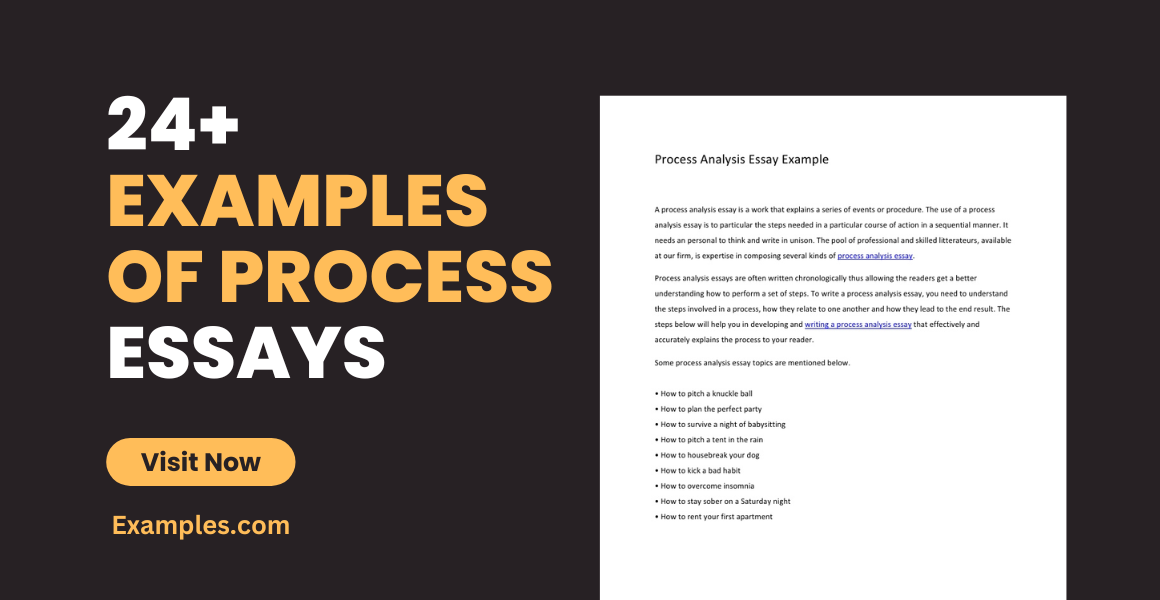
Do you know all those YouTube do-it-yourself (DIY) tutorials that they post online? When you consider posting that other than a process essay, it usually attracts more viewers and generates more subscribers on your YouTube channel as people these days are considered more visual in terms of learning new skills or facts. But process essays are just more than how-to videos or DIY videos, an accurate description of a process essay is that it simply describes a procedure. You may also see a short essay .
- 22+ examples of free essays .
- 10+ Essay Writing Examples
This kind of essay provides a step-by-step explanation of a process that leads to an expected or planned outcome. What people do not know that the aforementioned process may either be concrete or abstract. Simply put, there are two types of process essays: directional process essays (give instructions in steps on how to accomplish a specific task), and informational process essays (explains or analyzes a process). You may also see self-introduction essay
Student Process Essay Example
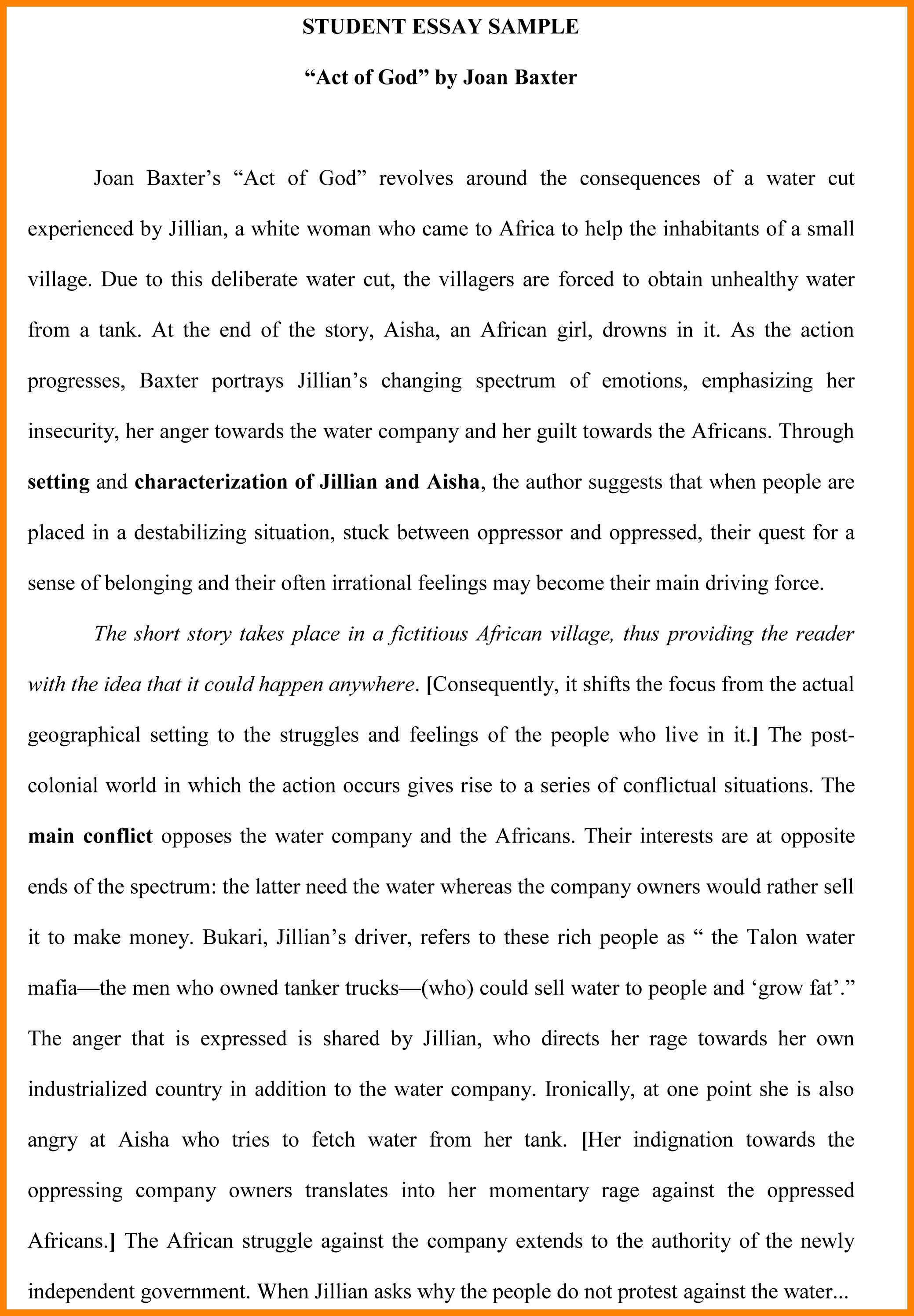
Size: 615 KB
Process Analysis Essay Example
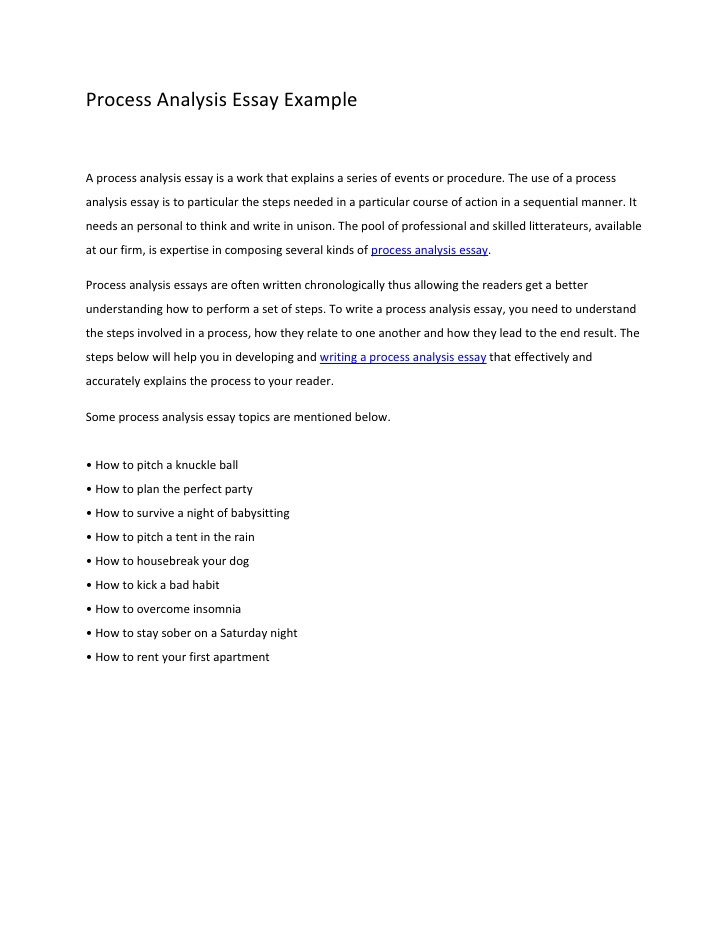
Size: 66 KB
Plain Process Essay Example
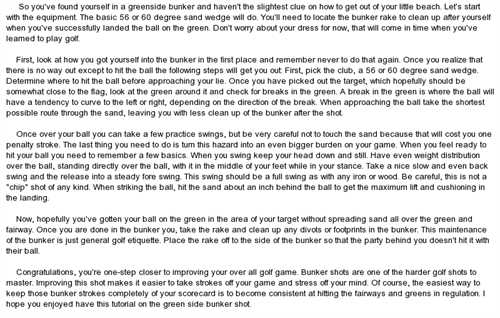
http://degregoristore.com/
Size: 53 KB
Preparation in Writing a Process Essay
1. assess your audience’s skill level.
Before you begin, you need to first take your audience’s skill level into consideration. In a lot of DIY videos and how-to videos that you see in numerous TV shows, you can see that the hosts will often make use of very simple language so that the people who decide to subscribe on their YouTube channels and watch those DIY videos will be able to understand them very easily. Another thing that you should assume is that everyone who decides to check out your videos or read your process essay has little to no knowledge of the said topic, depending on the content you decide to release or publish. Before you even begin to write your essay, you have to understand the parts that comprise an essay .
For example, a process essay intended for professional chefs could probably skip a description of how to chop carrots and just say, “Finely chop the carrots,” instead.
2. Make a list of the materials needed
If you already have an idea on what kind of process you are going to release or publish, the next thing to do would most probably be to draft a list of the materials or ingredients that your audience or viewers might need so that they can follow along. It may be easier to do so in your own DIY or “How To” videos, as it is more visual and that the viewers could clearly see as to what these products look like should they get confused, but for process essays, it is a bit tricky. One tip that you could follow would be to include a comprehensive “Things You’ll Need” section at the beginning of the paper or simply list the materials needed after the introduction so that the readers of your essay will prepare the materials needed beforehand to save precious time. There are moments in your life that you will be asked to draft up self-introduction essays as part of a class assignment.
There are times that an item on the list would seem very unusual for a person to procure. Should that be the case, such as a particular type of hand tool, be sure to clearly introduce it within the text. For instance, “The pin hammer has a finer tip than a standard hammer, making it suitable for more detailed work.” If at all possible, make sure to include a picture of the said object you are planning to use if you intend to publish the said essay online. You may also see a formal essay .
3. Create an outline of the task
In order to make things simpler for you on your end, it would be best if you created an outline that can help you create the flow of the process essay that you are working on. Keep in mind that the outline simply acts as the guide for the essay and is not the essay itself. Outlines are normally made with bullet points and at least 1 to 2 sentences per point. Creating an outline will be most helpful to especially informational process essays. Keep in mind that the more specific your article or essay topic, the more specific your details need to be. Here are some examples of how different people would write their essays .
- If your essay happens to be about cooking lasagna, you may want to begin your initial outline by saying, “Mix in basil.” Before you start writing, you could expand your outline to say, “Briefly mention taste differences between dried and fresh basil.”
- When writing an informational process essay outline about how journalists write a news report, you can include some details about journalists select a news story and the criteria they would use to determine a story’s newsworthiness.
Simple Process Essay Example
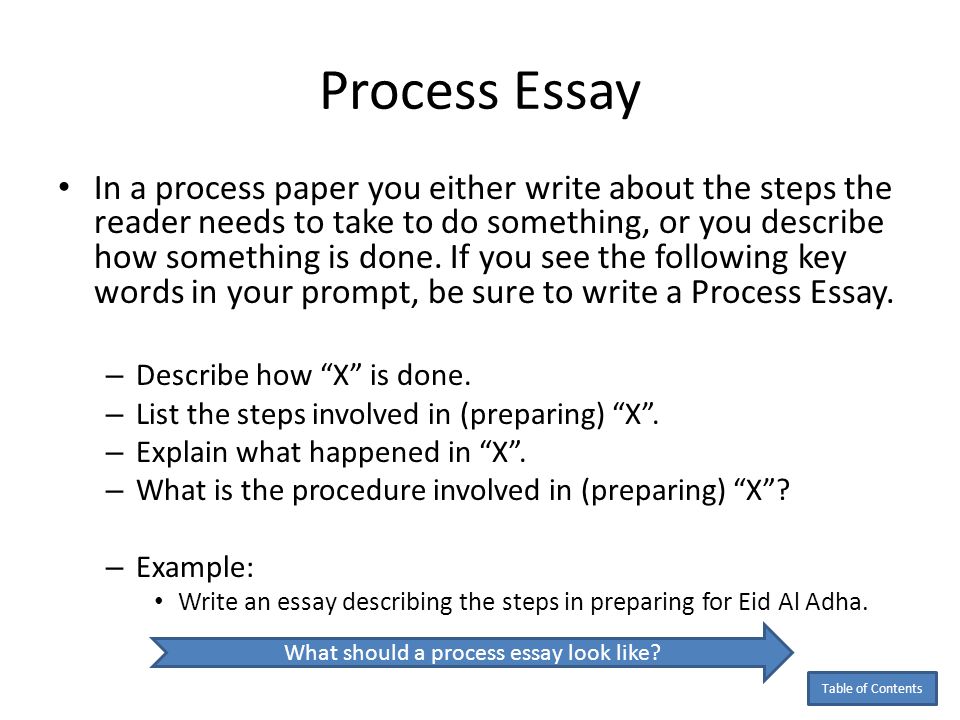
Size: 96 KB
Process Essay Example from Kool-Aid
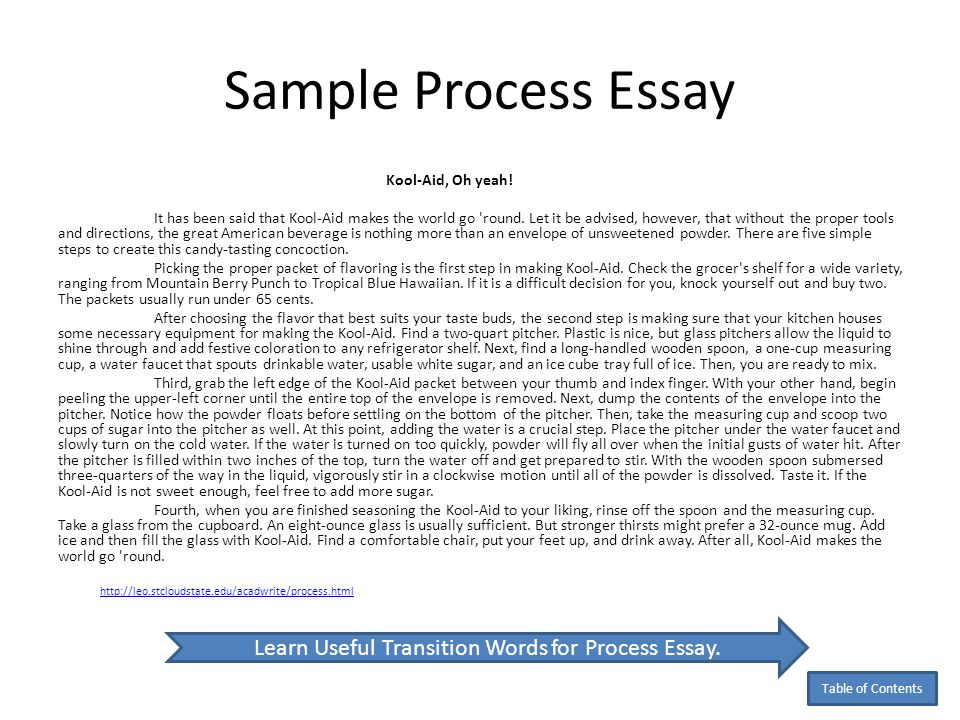
Size: 159 KB
Scanned Written Process Essay Example

Size: 76 KB
Golf Process Essay Example
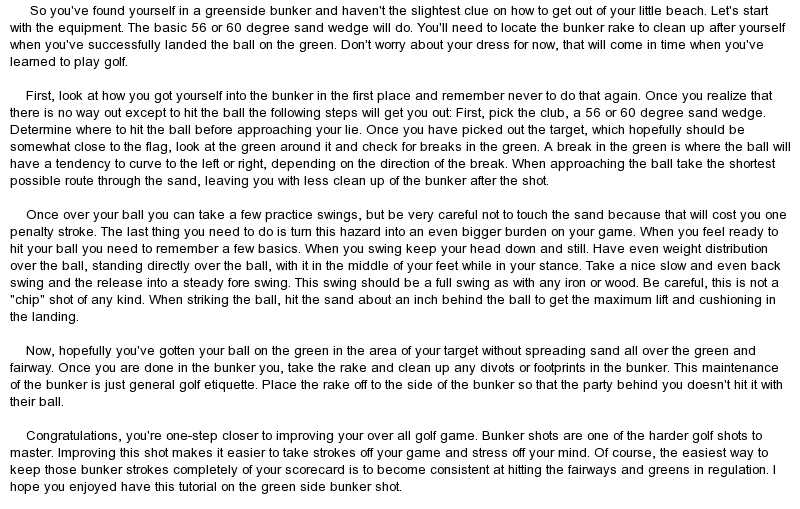
Size: 138 KB
Process Essay Example in Making Popcorn Balls
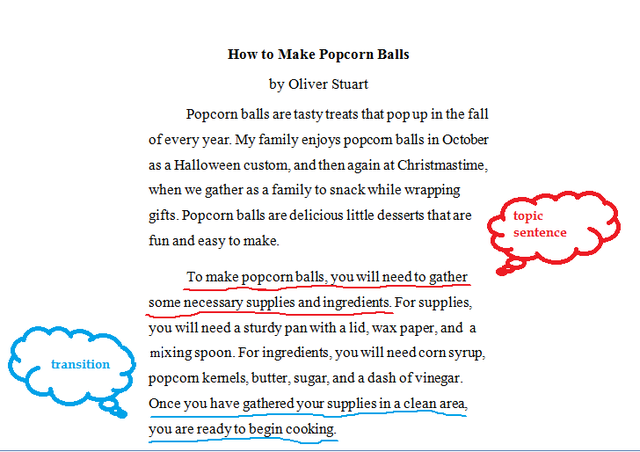
Size: 130 KB
Crafting Your Introduction
1. Grab your reader’s attention within the first 1–2 sentences. Today’s readership has a very short attention span. You see books being made into movie adaptations. Some books are being even made into TV shows for a longer and more detailed story line. Although there are some people who also prefer reading compared to watching, there are people who can tell a good book just by the first few paragraphs of the first page alone. You get that right, then you would have gained new readership. DIY and “How To” videos may be easy to create and draft a new introduction, but essays, not so much. It is usually the make or break stage for the essay. They say that when you start strong, it is just as important and vital to end strong as well. Leave the audience wanting to do more of your DIY projects or videos in the near future. Should you be interested in writing a reflective essay , you may want to click on the hyperlink on this sentence.
For instance, you might write, “The process of preparing lasagna has a rich heritage all of its own.”
2. Provide a general time estimate. Providing time estimates are very essential especially in writing these process essays as everyone might have some other plans other than doing the DIY video or following the process essay they happen to be reading. In cooking or baking, time is considered very critical. An example would be when the participants of MasterChef are asked to cook one of Gordon Ramsay’s signature dishes to avoid elimination. Even when cooking something as simple as scrambled eggs, one of the steps that Gordon suggested would be to stir over medium heat until the eggs start to cook.
The next step would be to remove the egg mix from heat and then continue stirring eggs for about 30 seconds. Return to heat, continue to stir eggs until they start to clump. He suggested that it is important to keep it “on and off” from the heat, otherwise, the eggs might be overcooked which as a result becomes watery. You would not want that to happen to your eggs, would you? Should you find yourself in need of writing an analytical essay , you may want to refer to the hyperlink found on the sentence.
3. If your process essay focuses on a cooking task, this is where you inform your audience to have some sort of clock or timer nearby for them to keep track of the number of minutes that have passed by and to place all the ingredients on the table beforehand.
4. Present the thesis statement as a problem. A thesis statement focuses your ideas into one or two sentences. It should present the topic of your paper and also make a comment about your position in relation to the topic. The thesis statement is considered to be the most important sentence of your paper as it informs the reader not only which problem you will be examining, but it should give them an idea as to how you will be able to solve the issue at hand. Your thesis statement should tell your reader what the paper is about and also help guide your writing and keep your argument focused. The thesis statement should be the last sentence of your introductory paragraph. Here are some examples of short essays that might serve as a reference in case you need assistance in formulating one.
5. You can start off your thesis statement like this, “This essay will explore how to create a complicated lasagna dish in a short period of time by preparing the noodles and sauce in advance.”
The Writing Process
Size: 25 KB
Pros and Cons of Adoption Essay Sample
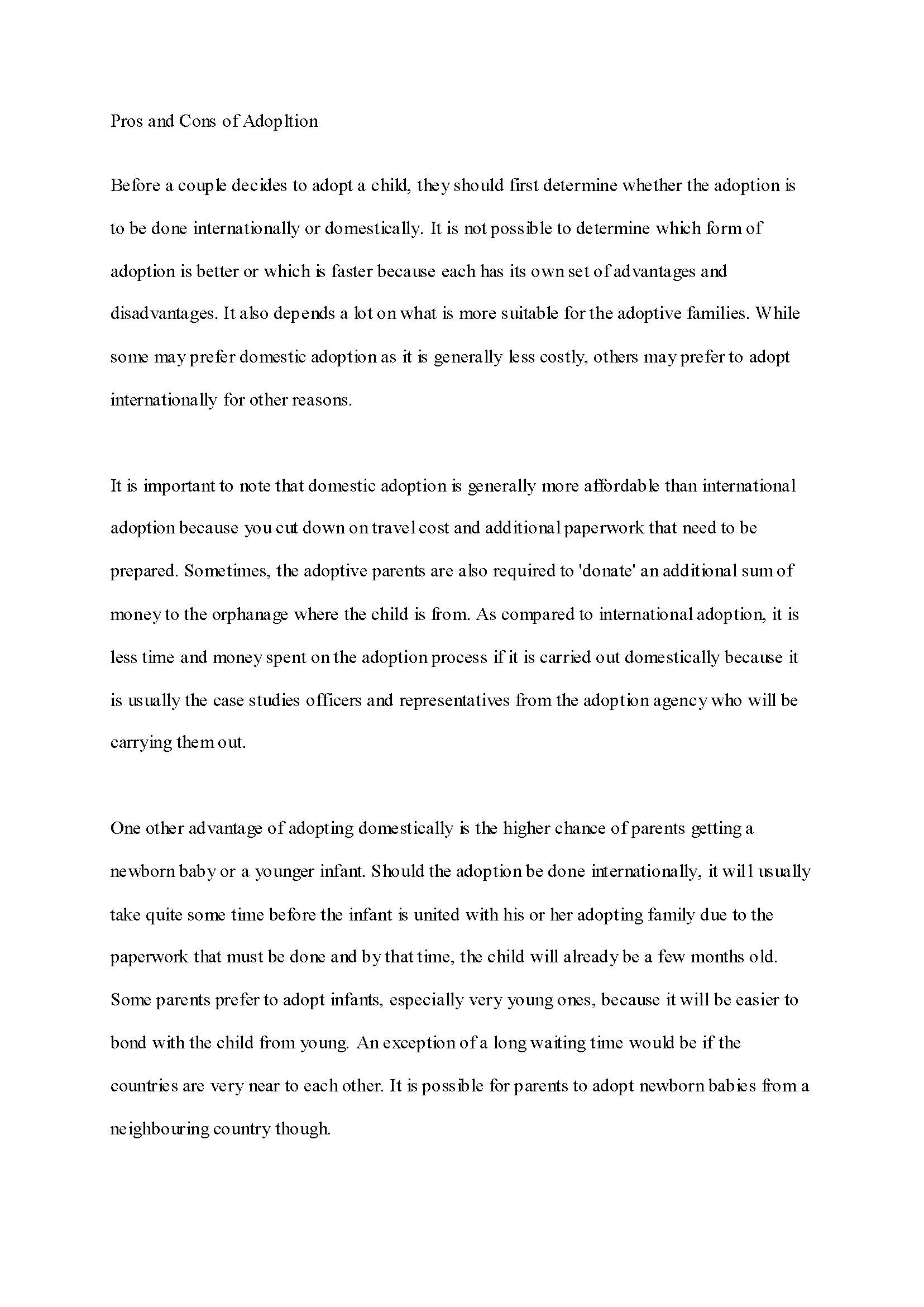
Size: 342 KB
Process Essay Example about Bathing Your Dog
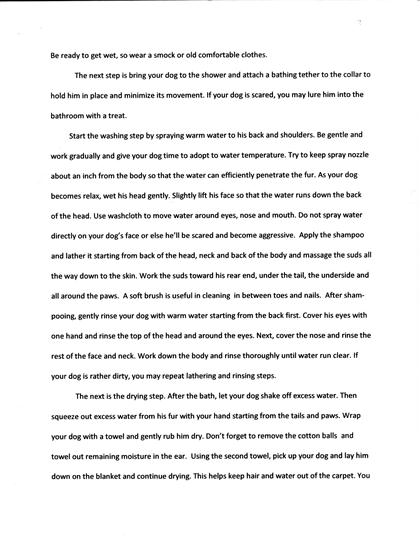
s3.amazonaws.com
Size: 45 KB
Basic Process Essay Example

Size: 756 KB
Writing Your Body Paragraphs
1. consult your outline.
People have the tendency to be sidetracked, especially when making their own stories or novels or any written work for their personal use or for their schoolwork. From time to time, it is best to try and consult with the outline that you have made as not to get lost and personally confused to where you currently are in your essay making process. As aforementioned, outlines are considered an excellent way to draft the flow of your speech or essay should you ever get lost somewhere in the middle of your essay writing. Always refer back to your bullet points if ever your point was not made somewhere in the body of the paragraph. The outline is not always right, it is merely temporary. The possibility of not following your outline might not actually exist if you have happened to draft a better one. For more ways to help start up your essay , you may refer to this hyperlink.
Try to be very careful with items that consist of multiple steps. Make the transitions clear enough and acknowledge prior steps regarding a particular item, if at all applicable.
2. Structure the body of the essay in paragraphs
The outline simply serves as the guide for your essay and is not really the speech itself. Since you have already given some thought into making the outline, now is high time to formulate the body of your essay. As much as possible, when you decide to do the initial draft of your essay, keep it in paragraph form. Bullet points may be simpler, but it is first and foremost an essay. For instance, if your process essay is about making the best shepherd’s pie, try drafting a paragraph on how to make the filling below and another paragraph on how to create good mashed potatoes on top of the lamb filling below. This, in turn, separates the two ideas for easy clarification.
Scholarship essays are normally written by applicants who wish to get their education at a lesser price, considering they uphold to the following conditions.
3. Add transitions in between steps
And since it is a process essay, it is very important that you place transitions on the steps to allow your readers to help identify as to what is Step 1 and what is Step 2. These transitions make it easier for the readers to help proceed to the next step without worrying they might have missed something on the previous step. Examples of some transitions would be the words next , first , later , then , finally , before , afterward , etc. For some examples of formal essays , you may refer to the hyperlink.
For instance, you could write, “Next, place the pot on the stove,” to move from one paragraph to the next.
4. Avoid using first-person pronouns
Including I , we , us , me , mine , our , and ours within your writing can make it seem less declarative and authoritative. In a process essay, this can make a reader less likely to trust your instructions. Instead, stick with a second and third-person perspective by using words, such as it or they . Here are some examples of argumentative essays for your reference.
For example, you could write, “This essay shows…” instead of “I’ll show.”
5. Mention any cautionary notes
Some people would normally forget to add that at the end of the process essay. This is perhaps one of the worst things that the author will not bother doing since he or she did not think that the reader will go to that extent of not following what was written. As someone who has written the process essay in the first place or a notable DIY star on YouTube, please mention some of the mistakes or actions that people tend to do when performing the said task. By doing so, you might actually save a life when you warn people beforehand. These cautionary notes serve as a warning to people as it might have already happened to some unfortunate people already. So when you are warned not to microwave your electronic devices for the sake of fun, just do not. For reference in writing personal essays , you can go through our website to find out more.
For example, you might caution a reader to “Cook the meat until it is no longer red in the center.” This advice will help them to avoid foodborne illness.
Process Essay Example about Hosting the Pre-Homecoming Dance Dinner
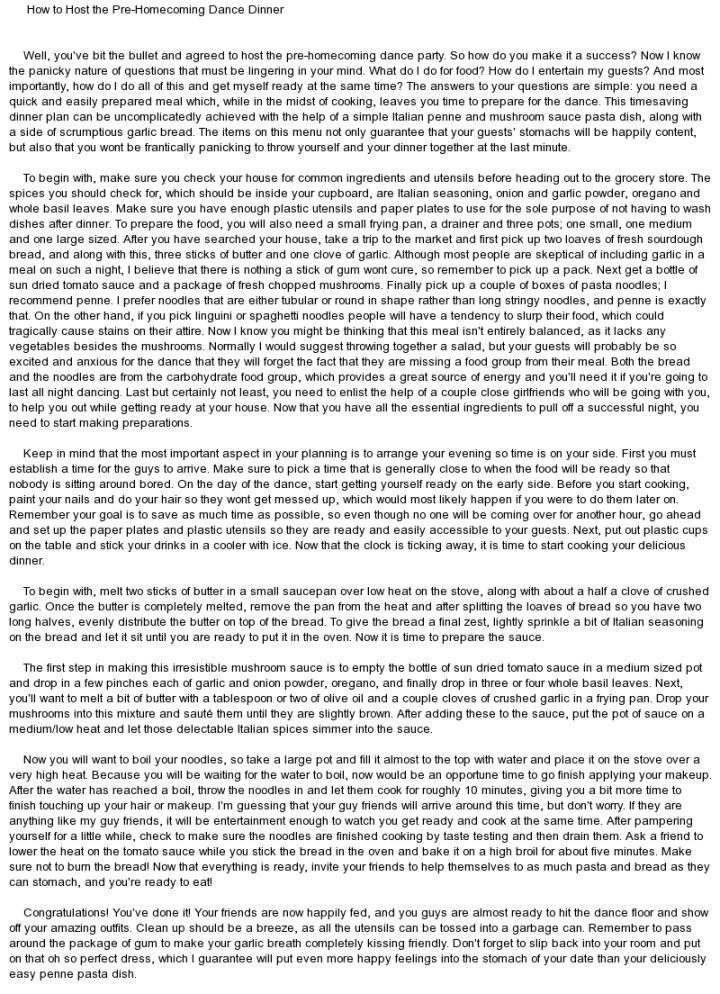
Size: 262 KB
Process Essay Writing Example
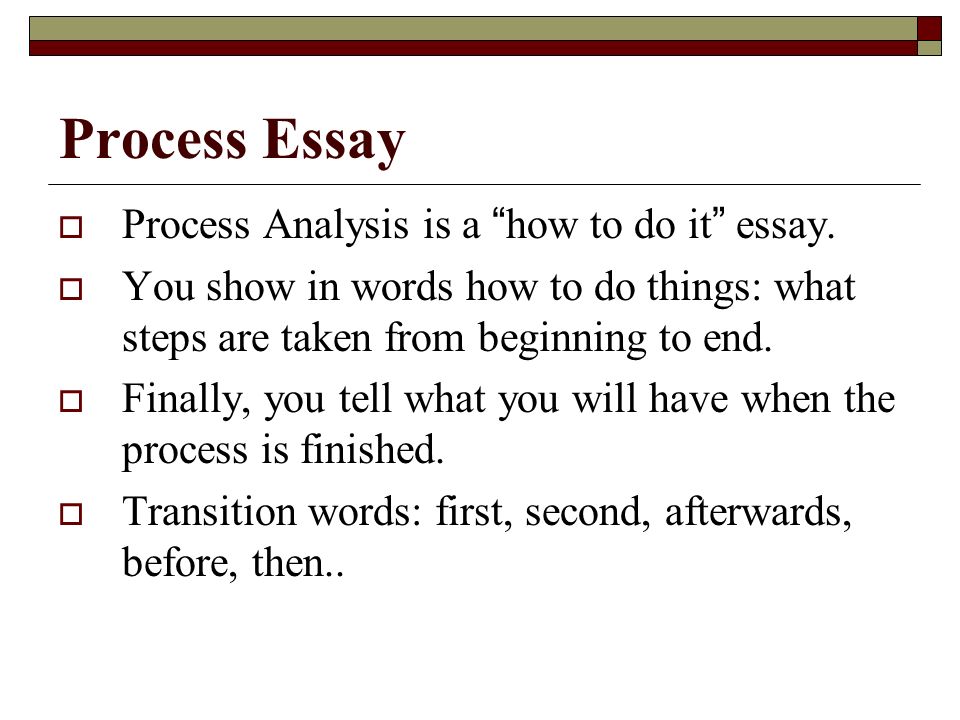
Size: 79 KB
Sample Outline of a Research Article
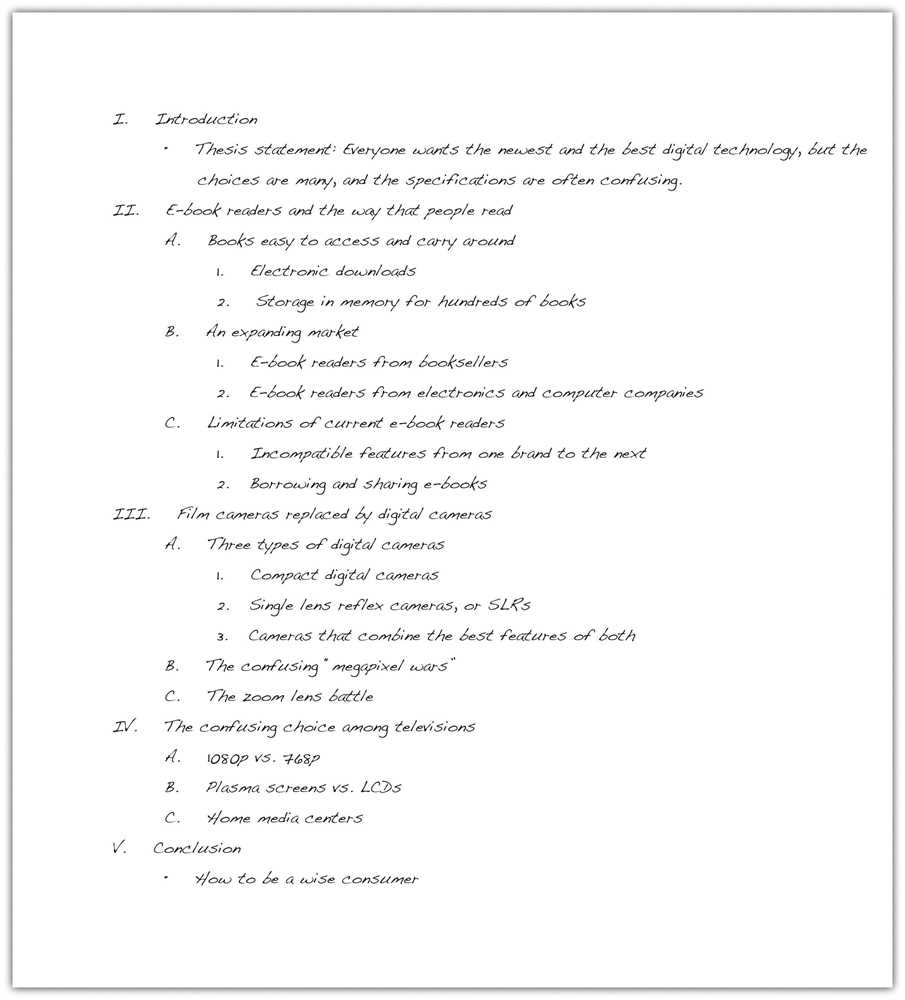
Size: 78 KB
Process Analysis Essay Writing Tips

Size: 95 KB
Odor Nuisances Sample Essay
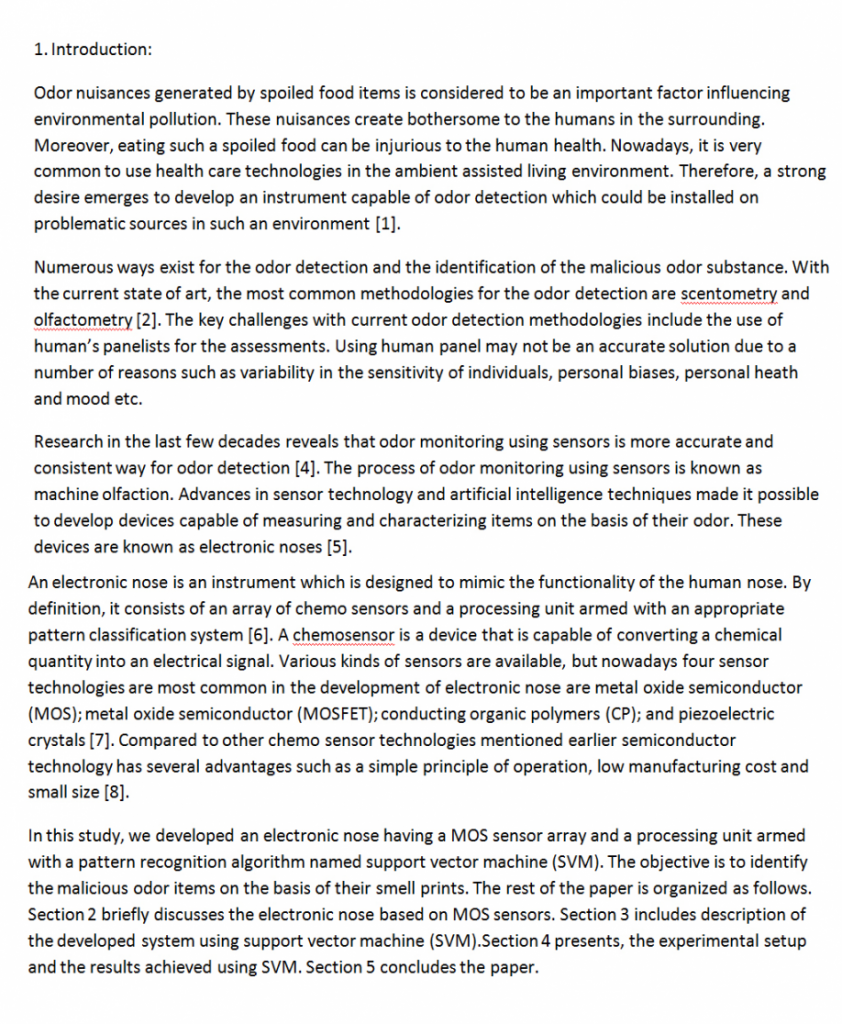
Size: 776 KB
The Process of Building Stonehenge Research Paper
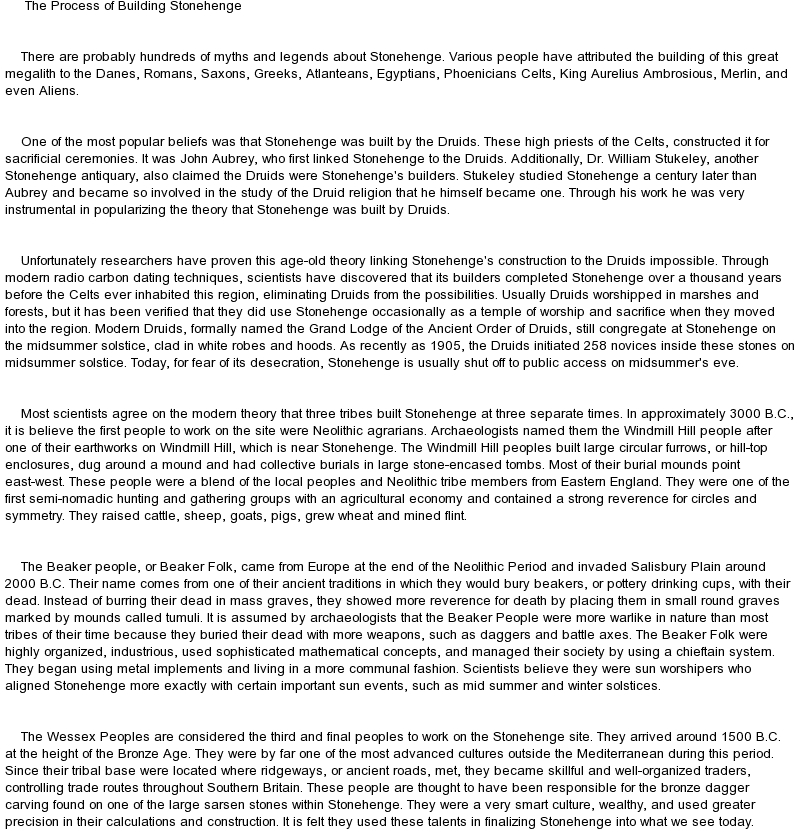
Size: 241 KB
Wrapping It Up
1. Mention the end product and what to do with it. At the last few minutes of the DIY video or the process essay, you can see that you are almost through making the said product. Now, there are some people who might already have an idea of what to do with them. For example, let us say that you are done making the recipe for the coffee jelly dessert. You can provide suggestions as what to do with the coffee jelly that you have made (e.g., After cutting the coffee jelly into cubes, pour it into a tall glass and pour some cold-brewed coffee to give it that extra flavor. And finally, top it off with some ice cream and place a spoon or straw. Best served chilled with family and friends). Here are some tips and examples that you might need when writing a thesis statement for your narrative .
2. Restate the importance of the task. Cooking has proven itself to be quite a challenge, especially when one has no background or experience in cooking. It can otherwise be daunting, and there will be times that you will feel like passing out or giving up. But if you hold on to the very reason as to why you are doing it in the first place, it will keep you focused on completing the task at hand quicker than expected. To be quite fair and frank, this is often utilized by marketing stunts everywhere even in making DIY arts and crafts projects for Father’s Day and Mother’s Day. Here are some examples of persuasive essays that can serve as a reference when writing essays.
3. A basic example of a newly-made dinner intended for your parents’ anniversary might be, “And there you have it! A delicious yet quick meal fit for the two of them to enjoy which looks complicated and sophisticated but is actually simple enough with enough practice. Next time, experiment with different herbs and spices to find your own spin on this classic dish.”
4. Check your essay for ease of reading. Now that you are through writing your essay, the next best logical thing to do would be to actually take some time to review them. If you think you are satisfied with the flow of the essay that you have written, then you may publish it with ease. But if you do not think you are comfortable or assume that there is something lacking in the process essay, take the time to double-check the content and add the necessary content to the essay. While you are in the middle of double-checking, try adding a few final touches to your essay for it to sound better. Lend your essay to a friend or family member to check if they had understood the whole process. Here are some examples of academic essays .
5. One tip would be to see if there are certain steps that you can eliminate or condense your instructions as not to take up too much space in the essay. A reader is more likely to finish directions that they can easily skim through.
6. Proofread your essay. Finally, proofread your essay. Don’t rely on spell-check alone, as it cannot account for context and doesn’t catch every error. But other than spell-checking your essay, make sure to also check for typographical errors in terms of grammar and preposition, subject-verb agreement, etc. Keep in mind that people from all over will be reading your essay, so make sure that it is written professionally in whatever language you will be using. Here are some examples of high school essays that you can refer to.
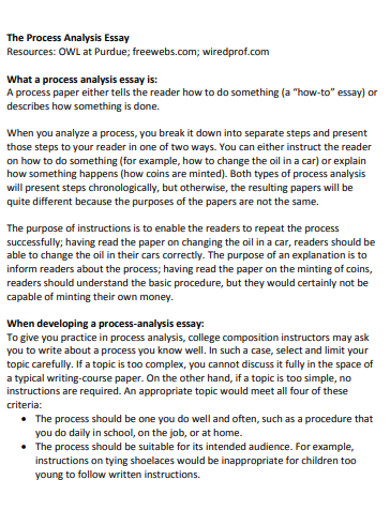
Size: 198 KB
Expository or Process Essay Example
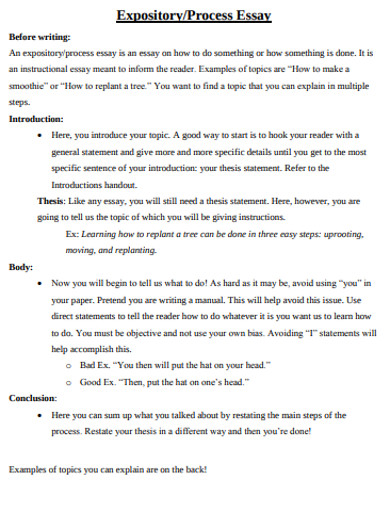
Size: 329 KB
Minimalist Process Essay Example
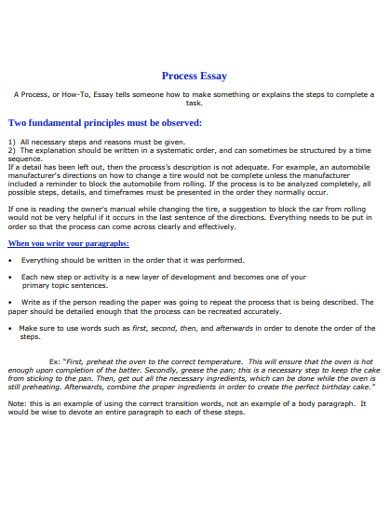
Size: 90 KB
Process Essay Example in PDF
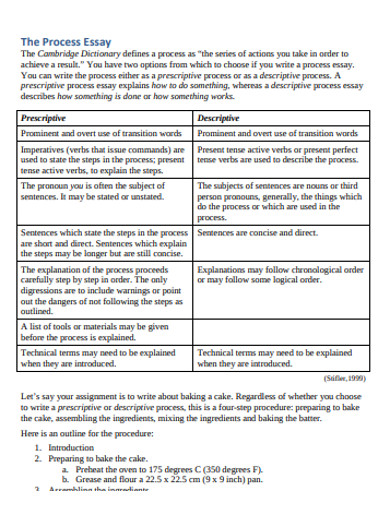
Size: 109 KB
Fundamental Process Essay Example

Size: 64 KB
Cheerleading Routine Process Essay Analysis Example
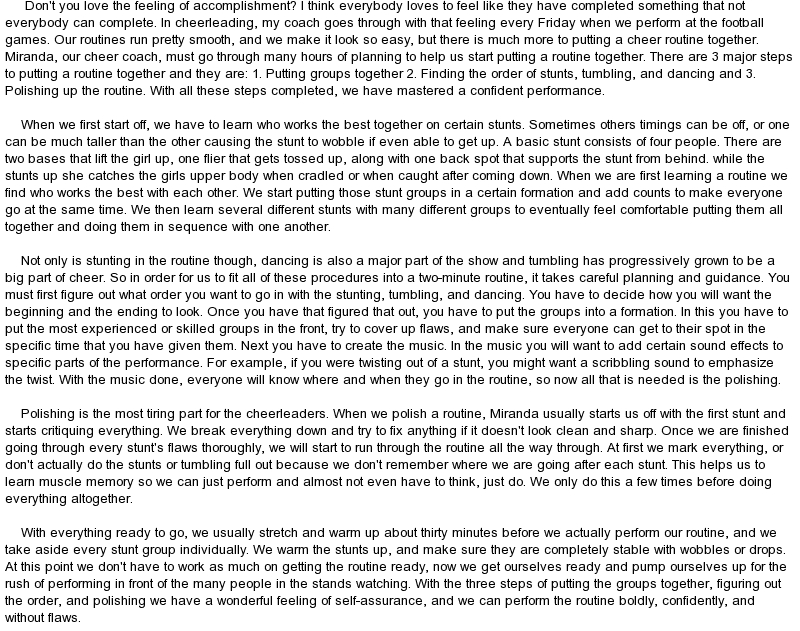
Size: 220 KB
Interesting Process Essay Ideas to Write in 2019
2019 is considered the “Year of the Earth Pig.” This could indicate laziness; however, it could also depict enthusiasm for some people. Considering that the usage of social media and the internet in this year is prevalent, people tend to view loads of various information that shape their own perspective. Moreover, this era strongly pushes the empowerment for every individual to showcase themselves, abling them to do what they want to do. Conclusively, the freedom of this age provides people a wide variety of interests.
A process essay explains the how-tos of a certain topic. Now that you already tackled the basics of this composition as well as the steps in making one, we are giving you in this section some exciting ideas that you can use in writing your own process essay for this year, 2019. According to your preference, you may consider selecting from these topics:
1. Technology-based ideas
2019 is a year that belongs to an era of rapidly innovating technology where gadgets and internet are major tools for almost everybody. Hence, it is not a surprise that people commonly ask some steps regarding technology. In writing your 2019 process essay, here are some examples of technology-based ideas:
- How to create your own Facebook account?
- How to reboot your phone?
- How to create your own Instagram account?
- How to upload several pictures on Facebook in 3 simple clicks?
- How to invite someone to play an online game?
- How to rank up in Mobile Legends?
- How to call someone via Messenger?
- How to use Snapchat as a newbie?
- Step-by-step guide in composing your first tweet
- How to perform a factory reset on your phone?
2. Smart aesthetic hack ideas
The presence of the internet also paved the way for beauty online influencers to showcase their own intelligent ideas. Consisted of mostly females, different channels and blogs fascinate their audience with their various mind-blowing hacks in grooming oneself. They also give some out-of-the-box solutions to the common aesthetic dilemmas. Basically, topics under this section range from fashion to beauty tips bonanza which include:
- How to transform a shirt into a skirt?
- How to rescue your shattered face powder?
- DIY T-shirt printing
- How to brush teeth the correct way?
- Alternative ways to curl hair
- How to make your own anime costume?
- How to make your own natural body scrub?
- How to do your full-face make-up in 3 easy steps?
- How to select the perfect sunglass for you?
- How to distinguish fake jewelry from genuine ones?
An important reminder, try to talk about processes that do not involve your audience’s health, especially if you are not a professional or your step is not yet widely studied.
3. Cooking hack ideas
Food is a basic necessity for each individual and just like the previous one, the internet also provided the cooking pros a medium to share their impressive easy-to-do recipes and strategies in preparing edibles. This extends from simple snacks and desserts to meals of rare occasions, turning simple white plates to something you can boast your friends of. These ideas may include:
- How to make a home-made chocolate fudge?
- Simple steps in making a no-bake cake
- How to slice onions the correct way?
- Impressive ways to plate your meal
- Easy-to-make soup recipes
- How to brine a turkey?
- How to make the perfect sandwich for your kids?
- How to boil eggs perfectly?
- How to remove avocado seed fast?
- Step-by-step guide in assembling cake layers
Process Essay Generator
Text prompt
- Instructive
- Professional
Write a Process Essay on how to prepare for a high school exam.
Discuss the steps involved in writing a research paper for your Process Essay.
- IP – S24
- Innovations – S24

- About Professor Nathenson
- Legal scholarship
- Other writings
- Scholarship on SSRN
- Scholarship on Bepress
- IP@STU: IP Certificate
- About Civil Procedure
- Assignments
- Study resources
- Nathenson.org MBE resources
- YouTube MBE playlists
- Subject matter jurisdiction
- Due Process, notice, service
- Personal jurisdiction
- Erie Doctrine
- Motions, trial, judgments
- Claim & Issue Preclusion
- Innovations & Patent Management
- Intellectual Property
- Trademark & Branding Law
- IP certificate
- - About Professor Nathenson
- - C.V.
- - Contact me
- - Legal scholarship
- - Other writings
- - Scholarship on SSRN
- - Scholarship on Bepress
- - IP@STU: IP Certificate
- - About Civil Procedure
- - Syllabus
- - Assignments
- - Study resources
- - About Professor Nathenson
- - Nathenson.org MBE resources
- - YouTube MBE playlists
- - By topic
- - Subject matter jurisdiction
- - Due Process, notice, service
- - Personal jurisdiction
- - MBE: Venue
- - Pleadings
- - Joinder
- - Erie Doctrine
- - Discovery
- - Motions, trial, judgments
- - Claim & Issue Preclusion
- - Appeals
- - Innovations & Patent Management
- - Intellectual Property
- - Trademark & Branding Law
Tips & Techniques for Civ Pro Essay Exams
WHAT IS IRAC?
What is it? As you know, it’s issue-rule-analysis-conclusion. We talked about IRAC, FIRAC, and IFRAC early in the semester .
Is IRAC the actual structure of all essay answers? Yes and no . IRAC is the heart of legal analysis. You need to make the main issue clear, give the main rule, give the analysis, and give the main conclusion. However, the actual structure of your essay will depend on the fact pattern, the call of the question, and the legal issues raised by both .
Do you mean I shouldn’t do pure IRAC? In a sense that is exactly what I am saying. For instance, imagine a simple diversity SMJ essay question. You will have to discuss amount in controversy (AIC) and complete diversity, right? But there can be additional issues contained within the issues, right? For instance, AIC includes the text of the statute as well as the St. Paul Mercury rule. And complete diversity can have a whole bunch of issues, which might include: the law under 1332(a)(1), (2), or (3), U.S. Citizenship, foreign citizenship, lawful permanent residence status, domicile (and the various domicile tests!). In a personal jurisdiction (PJ) essay, you may have lots of things to discuss depending on the facts, such as: long-arm, traditional bases, general jurisdiction, specific jurisdiction, and more! So in reality, even the simplest essay question may include a whole bunch of legal issues and sub-issues. Thus, it doesn’t always make sense to lump all the law under a “rule” section and all the analysis in a section below that.
What might happen if I lump all rules together and write all analysis separately? In other words, if you do pure IRAC (all rules together, all analysis in separate section), it’d probably be a bad answer.
- Such an essay answer would be hard to write, hard to organize, and would likely omit some sub-issues and sub-analyses.
- Your paragraphs would be long, unwieldy, poorly organized, and poorly written.
- You would probably not get a very good score.
So what do I do? You need to organize your essay in light of the facts, the call of the question, the issues, and the law. This requires recognizing essay questions that have multiple issues, or that have issues that contain sub-issues!
- That might mean that your actual structure will include multiple IRACs.
- That might mean that the “analysis” portion of your “analysis” (the “A” in IRAC) may contain one or more sub-IRACs.
Suppose you’re given a relatively simple fact pattern ( click here to see, it’s part of the other handout ): with one plaintiff and one defendant, where the call of the question is subject-matter jurisdiction (SMJ) and the only viable basis for SMJ is diversity. You should give the overall issue, overall rule, and overall conclusion. But the analysis will contain a number of sub-issues, each of which may contain additional sub-rules, sub-analyses, and sub-conclusions.
OVERALL ISSUE: Does the federal court in Florida have subject-matter jurisdiction in the suit between Peter and Deborah?
OVERALL RULE: Give main parts of diversity jurisdiction rule. Do not give every bit of law here; instead provide additional law when you get the relevant sub-issues. The two main parts of the overall rule, of course, are AIC (amount in controversy) and complete diversity.
AMOUNT IN CONTROVERSY (sub-issue #1)
SUB-ISSUE #1 : Does Peter’s claim exceed $75,000 exclusive of interest and costs?
SUB-RULE #1: Give rule for AIC from 1332(a) and St. Paul Mercury rule.
SUB-ANALYSIS #1: Apply the law to the facts. Counter-argue if a good counter-argument exists. Raise policy issues if appropriate.
SUB-CONCLUSION #1: State whether AIC is met. If sub-conclusion is tentative or contingent, explain why.
COMPLETE DIVERSITY (sub-issue # 2)
SUB-ISSUE #2: Are the parties completely diverse?
SUB-RULE #2: The rules you give here will depend on the facts. They might include the rule from 1332(a)(1), (2), or (3), plus additional law such as: definition of “citizen of a state,” timing of citizenship, standard(s) for domicile, treatment of lawful permanent residents, etc. Again, you do not have to lump all the law for all sub-issues here. Think about the sub-issues within the sub-issues. Yes, a sub-issue can have one or more sub-issues! Here you have to think about how you’d organize a sub-issue that has multiple parts.
SUB-ANALYSIS #2: Apply the law to the facts. Analyze the citizenship of each litigant separately . Counter-argue if good counter-arguments exist. Raise policy issues if appropriate.
SUB-CONCLUSION #2: State whether diversity is complete. If sub-conclusion is tentative or contingent, explain why.
OVERALL CONCLUSION: State whether SMJ exists. If main conclusion is tentative or contingent, explain why.
Use the tips above to organize and to write one (or more) of the SMJ questions available here . Bring me both your outline and your draft essay answer. Do the same thing for any of the PJ practice essays ( Amazone #1 , Amazone #2 , and Best Batteries ).
The sample outline above has a lot of sections! Yes, it does. There can be considerable thought that goes into even a simple SMJ fact pattern.
Will outlining and sub-headings help? Yep! As a start, always create an outline before you start to write. Then, turn your outline into subheadings. This will help you to organize your answer and to make sure you discuss all the issues and sub-issues that are reasonably raised by the facts and call of the question. Using subheadings will help you to keep your paragraphs focused and to avoid writing long yucky paragraphs.
Here are some additional drafting considerations, in no particular order.
Before the exam: create course outlines as a step towards exam preparation. One purpose of creating course outlines for each of your classes is to organize and master the material. Another purpose is to pre-organize law and legal issues so that you know how to organize those issues in your essays when you take your exams. Not every kind of law will be organized the same way. Some law consists of elements, some looks to the “totality of the circumstances,” and some law contains a list of non-exclusive factors. Other types exist. Also, some law combines one or more these approaches. In any case, any legal issue worth testing on will likely contain multiple sub-issues, as discussed above. So when you outline, figure out how you’d organize various topics. Some procedural law you read will contain an implicit order of analysis, whereas other law will not and you will have to come up with a way of organizing it. Your job as a student is to think about essay organization before you sit for an exam, and not while you are taking the exam .
During the exam:
- Argue the facts presented. A common error with essay exam answers is failing to argue the facts provided. Sometimes relevant facts are omitted from the answer. Other times, students change the facts or add facts not contained in the fact pattern. Usually this happens when a student rushes to write and misreads the facts. Other times it is because a student wants to answer based on his or her own facts rather than the facts provided. Don’t do that! However, if after careful review of the fact pattern you still believe that additional facts are needed for your analysis, you should state what those facts would be, and how they would affect your analysis.
- Focus on the issues raised. Do not raise irrelevant issues. Use your judgment as to the main issues that are likely to be worth more points. Minor issues are likely to be worth fewer or no points.
- No negative issue-spotting. You get no points for “negative issue-spotting.” Here’s a handout on negative issue-spotting . Here’s another one . If the call of the question asks for discussion of personal jurisdiction, you get no points for discussing subject-matter jurisdiction. So don’t squander your valuable time.
- Do not be conclusory. Always provide the “because.” If you state a conclusion without indicating (in that sentence or surrounding sentences) “why” or “because,” then you’re probably being conclusory. Conclusory is bad.
- Write legibly, write grammatically, and do not misspell or misstate key terms. This speaks for itself.
Do I cite cases and statutes?
- Case names versus the law contained in cases. Stating a case’s name without the relevant rule of law gets you no points. Instead, you must be able to state the applicable law found in relevant cases. In fact, it does not matter if you can’t state case names so long as you are able to state the relevant law (as well as identify relevant splits in the law). Thus, you may state the case name along with the rule of law. Or simply state the rule of law without the case name.
- Statutes and rules of the FRCP. Similar considerations exist regarding citing statutes and the rules of the Federal Rules of Civil Procedure (“FRCP”). Making a conclusory statement and saying, “See section 1331(a)” is not stating the rule of law. You must state what the law is , not just its section name. Thus, if you can cite the statute and the law contained within the statute, great. If you can only remember the law contained within the statute but not its citation, that’s fine too.
Finally, some organization & time-management tips.
Don’t start writing immediately!
- Read the instructions carefully. They’ll tell you the value of each question and give suggested times. Also, for users of blue books, write on every other page, every other line: 1) it’s cleaner and easier to read; and 2) if you miss something and have to go back to clarify or add something in, you’ve got room to work with.
- Read all questions carefully. Read an essay question several times before outlining an answer. Read it again after outlining and before writing. Read it again after you write your answer (to see if you’ve missed anything).
- Draw a picture. Diagram the litigation. It will help you to spot relevant legal issues.
- Do a “fold” outline. What I mean is that you might try folding a piece of paper in half: on the left-hand side, put the law (rules, standards, factors, etc.). On the right-hand side—across from the applicable law—put all the relevant facts that each side will use to argue. This method of outlining might help you to organize your answer and to spot good counter-analysis to go with your analysis.
Other time-management tips. Sometimes students have difficulties finishing the all of the questions in the time provided. Address this issue by:
- Watch the clock. Know how much time is suggested for multiple-choice questions and essays. My instructions aways state how much time I suggest for each part of the exam, and the points are weighted accordingly. Don’t spend the entire time writing a brilliant answer to one essay question and then run out of time for other essays and multiple choice questions.
- Don’t use all your time on one question. Not squandering too much time on essay questions that are worth fewer points. For example, if one question is worth 20 points with a suggested time of 20 minutes, and another is worth 80 points with a suggested time of 80 minutes, it would be inadvisable to spend 80 minutes on the first question.
- Be prepared and know your doctrine well. This minimizes “remembering” time and aids organization. I do provide copies of relevant provisions of the Constitution, statutes, and FRCP for you to use in the exam. But if you don’t know that law well already, then you will waste too much time reading them during the exam. Needless to say, the first time you read an FRCP rule should not be during the exam!
- Outline before writing. This helps you capture and organize all of the issues before you start writing, so the writing flows quickly. A few minutes organizing saves a lot of time that would otherwise be spent back-tracking and head-scratching during your writing.
- Outline. If you start to run out of time, give a quick outline of what you intend to say. Any such outline must be within the text in your essay answer and not contained elsewhere (such as in a blue book or in a separate part of your Examsoft answer). I may give partial credit.
Last revised Sept. 11, 2020 (revising link visibility); Sept. 29, 2016 (major revision); Oct. 1, 2019 (minor formatting, adding “analysis” heading to box)
In the order page to write an essay for me, once you have filled up the form and submitted it, you will be automatically redirected to the payment gateway page. There you will be required to pay the entire amount for taking up the service and writing from my experts. We will ask you to pay the entire amount before the service as that gives us an assurance that you will come back to get the final draft that we write and lets us build our trust in you to write my essay for me. It also helps us to build up a mutual relationship with you while we write, as that would ease out the writing process. You are free to ask us for free revisions until you are completely satisfied with the service that we write.

Finished Papers
Customer Reviews
We use cookies. By browsing the site, you agree to it. Read more »

There are questions about essay writing services that students ask about pretty often. So we’ve decided to answer them in the form of an F.A.Q.
Is essay writing legitimate?
As writing is a legit service as long as you stick to a reliable company. For example, is a great example of a reliable essay company. Choose us if you’re looking for competent helpers who, at the same time, don’t charge an arm and a leg. Also, our essays are original, which helps avoid copyright-related troubles.
Are your essay writers real people?
Yes, all our writers of essays and other college and university research papers are real human writers. Everyone holds at least a Bachelor’s degree across a requested subject and boats proven essay writing experience. To prove that our writers are real, feel free to contact a writer we’ll assign to work on your order from your Customer area.
Is there any cheap essay help?
You can have a cheap essay writing service by either of the two methods. First, claim your first-order discount – 15%. And second, order more essays to become a part of the Loyalty Discount Club and save 5% off each order to spend the bonus funds on each next essay bought from us.
Can I reach out to my essay helper?
Contact your currently assigned essay writer from your Customer area. If you already have a favorite writer, request their ID on the order page, and we’ll assign the expert to work on your order in case they are available at the moment. Requesting a favorite writer is a free service.
1555 Lakeside Drive, Oakland
Extra spacious rarely available courtyard facing unit at the Lakeside…
Customer Reviews

Is essay writing service legal?
Essay writing services are legal if the company has passed a number of necessary checks and is licensed. This area is well developed and regularly monitored by serious services. If a private person offers you his help for a monetary reward, then we would recommend you to refuse his offer. A reliable essay writing service will always include terms of service on their website. The terms of use describe the clauses that customers must agree to before using a product or service. The best online essay services have large groups of authors with diverse backgrounds. They can complete any type of homework or coursework, regardless of field of study, complexity, and urgency.
When you contact the company Essayswriting, the support service immediately explains the terms of cooperation to you. You can control the work of writers at all levels, so you don't have to worry about the result. To be sure of the correctness of the choice, the site contains reviews from those people who have already used the services.

IMAGES
VIDEO
COMMENTS
Hook sentence. Background information. Thesis statement. Step 1: Begin with the basics. Describe the initial steps or preparations required. Explain any tools, materials, or ingredients needed. Provide safety precautions if necessary. Step 2: Break Down the Process. Divide the process into clear, sequential steps.
Process Essay Outline The structure of this paper is similar to any other assignment, meaning that it comprises of introduction, main paragraphs and conclusion. You need to create an outline to ease the procedure of writing process essay. Use bullet points not to forget the essential ideas you would like to deliver.
2. Make a list of the materials needed. Go through the process from start to finish and write down every single item that someone would need to complete the task. Include everything from the common to the unusual. Then, keep the list by you as you write and check off each item as you mention it.
The process essay, also known as the "how-to" essay, is commonly written for people or companies that need tutorials or a set of instructional steps. Whether it's building a robot or cooking a chocolate cake, process essays use a similar format for any variations. They follow a step-by-step style, with the initial step influencing the second ...
Revised on July 23, 2023. An essay outline is a way of planning the structure of your essay before you start writing. It involves writing quick summary sentences or phrases for every point you will cover in each paragraph, giving you a picture of how your argument will unfold. You'll sometimes be asked to submit an essay outline as a separate ...
Definition. A process essay is a typical "how-to" paper that describes some process or workflow, hence the name. The primary idea behind this type of essay is to give a step-by-step explanation of a process that leads to a planned or expected outcome. The paper may revolve around a concrete or precise and an abstract process.
Be accountable. 2. How something works. By contrast, this is an informative type of writing that aims to achieve one goal - explain the principle of work behind some process. Unlike the mentioned above type, this process essay type does not encourage a reader to take an action and do something step by step. However, you must make sure that by ...
Start by Brainstorming. The first step in writing your how-to essay is brainstorming. Here are tips to help you: Draw a line down the middle of a sheet of paper to make two columns. Label one column "materials" and the other column "steps." Write down every item and every step you can think of that will be needed to carry out your task.
1. Focus on Simplicity. As a guide on doing something, most probably for the first time, a process essay should be easy to follow and understand. Use simple language with clear directions on how to perform all the processes. The choice of words and the construction of sentences must meet the reader's understanding.
Learn about procedural writing by examining a procedural writing template. Identify how to write procedures using procedural essay and procedural writing examples. Updated: 11/21/2023
In groups, have them brainstorm a variety of titles for the text. When they are finished, reveal the original title of the text and compare it with the suggestions made by the group. Soon they will start to see the pattern evolve, which will help them when they come to produce and name their own procedural texts. 2.
The process essay is writing that explains how to do something or how something works by giving a step-by-step explanation. The explanation may be about a concrete process (how to skin a muskrat or how to plant begonias) or an abstract process (how to build self-esteem or how to overcome a loved one's death).
There is not much to say about the process essay outline because structure repeats steps required to complete a certain procedure. Having an outline is helpful in any situation associated with academic writing. Put down every stage in chronological order. Once the student has an outline, they may later add some details depending on the process ...
Process Essay. Process is a rhetorical style that provides step-by-step directions or guidance. You may encounter quite a few process essays of various types in academic writing—everything from a traditional process essay in which you choose a topic and describe the process to a lab report in which you describe the process of conducting a lab ...
The purpose of a process essay is to explain how to do something (directional) or how something works (informative). In either case, the formula for a process essay remains the same. The process is articulated into clear, definitive steps. Almost everything we do involves following a step-by-step process. From learning to ride a bike as a child ...
There are simple steps to take when writing a process essay. Consider the following process essay steps: 1. Come up With Ideas. Creating an outline is the first step in creating your how-to essay. Here are a few pointers to consider: Create two columns by drawing a line along the center of a paper.
But process essays are just more than how-to videos or DIY videos, an accurate description of a process essay is that it simply describes a procedure. You may also see a short essay. 22+ examples of free essays. 10+ Essay Writing Examples; This kind of essay provides a step-by-step explanation of a process that leads to an expected or planned ...
Any such outline must be within the text in your essay answer and not contained elsewhere (such as in a blue book or in a separate part of your Examsoft answer). I may give partial credit. Last revised Sept. 11, 2020 (revising link visibility); Sept. 29, 2016 (major revision); Oct. 1, 2019 (minor formatting, adding "analysis" heading to box)
The first step in making your write my essay request is filling out a 10-minute order form. Submit the instructions, desired sources, and deadline. If you want us to mimic your writing style, feel free to send us your works. In case you need assistance, reach out to our 24/7 support team. Literature Category.
Procedural Essay Outline: Some FAQs related to our essay writer service Go through the below-given questions and get your answers from us. is a "rare breed" among custom essay writing services today. All the papers delivers are completely original as we check every single work for plagiarism via advanced plagiarism detection software. As a ...
Procedural Essay You will turn in your outline and a procedural essay with at least one piece of visual media. Before you submit your essay make sure you •Have included all information necessary to complete the process. •Have organized the steps logically •Use transitions to clearly show relationships among ideas or concepts.
Procedural Essay Outline: 8521 . Finished Papers. REVIEWS HIRE. Hire a Writer. Max Price . Any. Our best editors will run additional screenings to check the quality of your paper. 1(888)302-2675 1(888)814-4206. Jeremy. 4.7/5. Gain recognition with the help of my essay writer. Generally, our writers, who will write my essay for me, have the ...